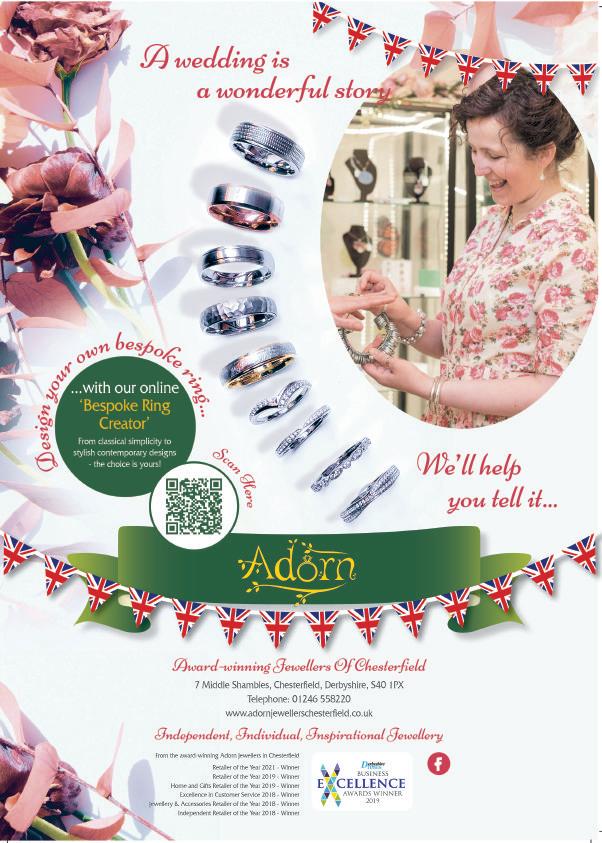














All that’s been happening in words and pictures across the county

16 The remarkable ‘Case of the Disappearing Duchess’ Patrick Coleman looks at the remarkable career of the CID officer who brought about the return of a stolen Duchess of Devonshire painting
30 Koji is definitely a patient’s best friend… Fiona Stubbs discovers how therapy dogs bring comfort and inspiration to hospital patients – and staff

36 When taps were dressed instead of wells!
In one Derbyshire town, as Catherine Roth discovers, they dressed taps before wells!
42 A fascinating selection of twin towns


Mica Bale picks out the local settlements with exotic twins
46 Fashion: It’s the season for shorts stories!
As temperatures start to rise, so do hemlines – meaning it’s time to give your wardrobe a short and sweet update, says Amy Norbury.
52 Spotlight on the Arts
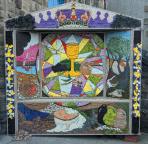
It’s Open Arts this month in Derbyshire, as Barrie Farnsworth reports
54 Queen Caroline and the Derbyshire archaeologist Rosy Thacker details the relationship between a Queen – much more popular than her husband, King George IV – and a Hopton Hall resident
60 Creating a wildlife garden in a small plot
With choice planting and careful habitat management, it is possible to create a haven for wildlife in the smallest of spaces, says Catherine Roth
66 Lovely images of a ‘season of hope’
Our latest, lovely selection of entries into our ‘Derbyshire’s Wonderful Flora & Fauna’ competition
70 ‘Walking the Walk’ for 173 years…
Chesterfield churches take to the streets again in 2023 for the historic Procession of Witness, as David Botham explains
72 Out & About
Steve Brown is over the border in Staffordshire this month – but the views on his walk are worth it!
74 Recipe of the Month
75 Focus on Food & Drink

A local pub and restaurant within a hotel is a multiple award winner this year


REFLECTIONS MAGAZINE MAY 2023
Editor: Barrie Farnsworth, barrief@bannisterpublications.co.uk
Advertising: Mike Snow, mikes@bannisterpublications.co.uk
Managing Director/Photographer: Robert Bannister, robert@bannisterpublications.com
Art Editor: Ben Fletcher-Bates, design@reflections-magazine.com

Accounts: Helen Holgate, admin@bannisterpublications.co.uk
Distribution: distribution@bannisterpublications.co.uk
Published by: Bannister Publications Ltd.
Tel. 01246 550 488 (3 lines). 118 Saltergate, Chesterfield, Derbyshire S40 1NG. Reflections is published monthly and delivered directly to homes which fall into tax bands D to H and the following postcode areas: DE4 - 2, 3, 4, 5 / DE45 1 / S18 5 / S30 1 / S40 - 1, 2, 3, 4 / S41 0, S41 7, 8, 9 / S42 - 5, 6, 7 / S43 - 1, 2, 3 / S45 0, S45 9.
All Rights Reserved: Reproduction in whole or in part without written consent is strictly prohibited. The publishers do not accept responsibility for any views expressed, or statements made, in signed contributions or in those reproduced from any other source. No responsibility is borne for any errors made in any advertisement, or for incorrect claims made by any advertiser. The publishers reserve the right to refuse any advertising deemed unsuitable for any reason. All material submitted for publication is done so at the owner’s risk and no responsibility is accepted for its return. Reflections Magazine, Bannister Publications Ltd.
76 Antiques: From refugee to top retro designer Expert valuer and auctioneer Vivienne Milburn looks at the remarkable Kutchinsky family of jewellers
78 What’s On Out comprehensive guide to forthcoming events in the county and beyond


















These new tickets, called the Derbyshire Wayfarer, are being offered by all bus operators in Derbyshire.
Day tickets can be bought on all buses, or can be bought online and loaded onto special Wayfarer smartcards. Wayfarer cards will also be available in libraries and tourist information centres.
The Wayfarer tickets available are: one day for an adult – £8; one day for a child aged up to 16 – £6; one day for a group (2 adults and 3 children) – £15.50; seven days for an adult – £33; seven days for a child – £24.60. These prices are set for the next five months as an introductory offer. Wayfarer smartcards can be bought online at sytravelmaster.com.
The current Derbyshire Wayfarer ticket becomes the Derbyshire Wayfarer Bus and Train ticket.
The council was awarded £47m from the Government to improve bus services in Derbyshire, one of the largest awarded in the country. The new Wayfarer tickets are being funded from this money.
DERBYSHIRE Wildlife Trust has secured the purchase of 60 acres of land for local people to enjoy thanks to overwhelming support from the public, generous grants and philanthropic loans.
The piece of land at Old Whittington will be known as ‘Wild Whittington’ and is set to be rewilded. The site connects St Bartholomew’s woods to the south and Grasscroft ancient woodlands to the north.

The plan is to create varied habitats to bolster a vital corridor between the woodlands and support nature’s recovery in the surrounding areas.
Matt Buckler, Director of Natural Solutions at Derbyshire Wildlife Trust, said: “We are so grateful for the incredible response we had to our appeal to secure this land from our members, the public, and our generous major donors.
“The purchase is not only good news for wildlife, it’s great news for local residents and visitors to the area too. We can’t wait to turn this piece of land into an oasis for wildlife for future generations to enjoy.”
MAY 16 marks the 80th anniversary of the most famous single air raid of World War Two, “Operation Chastise”, better known as the Dambusters Raid.
This top-secret mission was the brainchild of Barnes Wallis. The
engineering genius, from Ripley, invented and developed what was famously to become known as the ‘bouncing bomb’. These special explosives were designed to be used to break three dams in Germany’s Ruhr Valley – the Möhne, Eder and Sorpe.
It was at Derwent Dam where 617 Squadron practised their high-speed, lowlevel training in their Lancaster bombers.
TWO local firms have been honoured in the first-ever King’s Awards for Enterprise. In total, 148 companies nationwide were celebrated in the awards, previously known as the Queen’s Awards for Enterprise and recognised as the UK’s most prestigious business awards.
Receiving an Innovation award was Archaeological Research Services Ltd, of Bakewell, for their non-intrusive landscape prospection service to detect the presence, or absence, of significant archaeological remains prior to development.
A Sustainable Development Award goes to Wirksworth-based Trade & DIY Products Limited (trading as TDP Ltd), whose aim is for positive impact through sustainable product design, strong ethics and good governance.
NEW tickets which offer unlimited bus travel across the county from £6 a day are now available, thanks to a scheme organised by Derbyshire County Council.
RENISHAW Hall & Gardens were presented with a plaque by the National Garden Scheme (NGS) in April to mark their 30 years of opening the garden for the charity. The hall and gardens are a popular destination for visitors throughout the season and host a variety of events, including two ‘open garden’ days for the NGS on Wednesday, May 3 and Wednesday, July 5 this year.
Pictured are Vernon Sanderson, Midlands chair for the NGS, Alexandra Sitwell, owner of Renishaw Hall, and head gardener David Kestevan.
Vernon said: “It is the loyalty, commitment and passion of garden owners such as Alexandra that make the National Garden Scheme the success it is, contributing to an annual donation of over £3 million to some of the UK’s bestloved nursing and health charities. Below: Alexandra Sitwell receives the plaque from Vernon Sanderson (left), Midlands regional chair for the NGS, with head gardener David Kesteven (right).
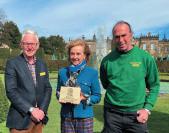





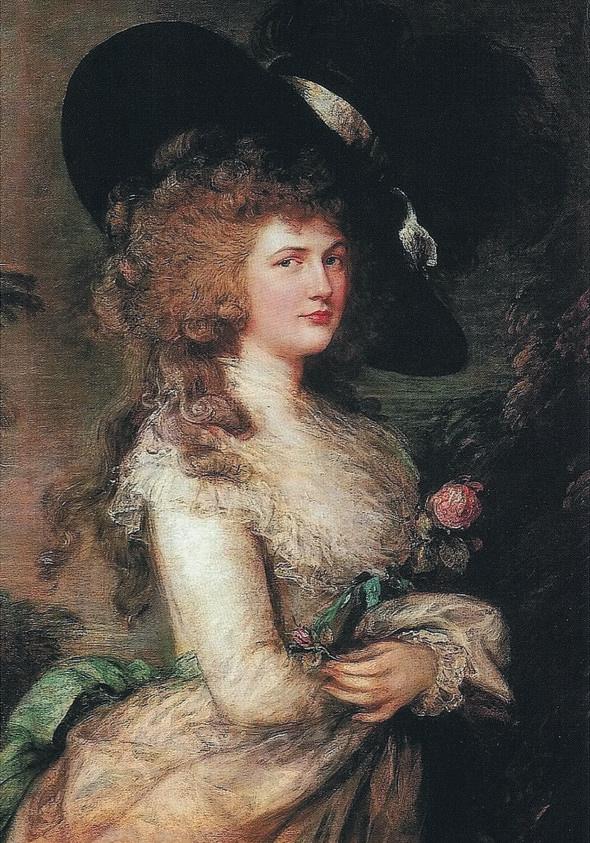
Left: Thomas Gainsborough’s famous painting of Lady Georgiana Cavendish, Duchess of Devonshire. It returned to its original home – Chatsworth House – in 1994, more than 160 years after it was last there!
Far right: Superintendent Donald Swanson, one of the finest detectives of his time, wrote in the margins of another policeman’s book who he thought was Jack the Ripper.
Right: Keira Knightley played Georgiana Cavendish in the 2008 movie, ‘The Duchess’.

MAY 26th 1876, and in the London gallery of art dealers Thomas Agnew & Sons, a daring heist is taking place. At the stroke of midnight, two shadowy figures keep watch along Bond Street, as a third – dressed dapperly in frockcoat and top hat – enters the Mayfair address via a first-floor window. Armed with little more than his audacious plan, the thief is lucky: everything remains quiet in the street below. In the main gallery, he jumps over the velvet rope which by day had kept the crowds from getting too close to Agnew’s star attraction. Then he carefully sets to work, cutting a canvas from its frame. By the morning “Georgiana, Duchess of Devonshire” by Thomas Gainsborough RA is missing, and Mayfair – all London in fact – is abuzz with news that the most valuable painting then in existence has been stolen!
As art heists go, the theft of Gainsborough’s painting was one of the most sensational of the 19th Century. The value of the picture (purchased by Agnew three weeks earlier for a then-record £10,000), together with the fame of the portrait’s sitter, combined to create an crime caper which held public attention for decades afterwards.
Nowhere was ‘The Case of the Disappearing Duchess’ more closely followed than in Derbyshire, the portrait’s original home. Painted circa 1785, it had first hung in Chatsworth House, home to the portrait’s subject, Georgiana Cavendish. It hangs there again today (for the painting was eventually recovered, as we shall see, and returned to Derbyshire in 1994).
Today, however, few visitors who pass by it in Chatsworth’s Sketch Gallery are aware of its colourful history. Forgotten in particular is the role played in the theft investigation by a pioneering Scotland Yard detective who was also a lead investigator in one of the most famous cases in criminal history: the Whitechapel Murders of the so-called ‘Jack the Ripper’.
This detective was Chief Inspector Donald Swanson (1848-1924), one of the earliest ‘CID’ officers. Until
recently, Swanson’s career was largely forgotten. Despite being involved in some of the most highprofile cases of his age, Swanson was a modest man. Unlike many of his colleagues, he declined to write memoirs of his time at Scotland Yard.
Only in 1981, when a descendant discovered Swanson’s personal copy of another officer’s (Assistant Commissioner Robert Anderson) autobiography were Swanson’s own thoughts on his cases finally revealed. It was discovered that in the margins of Anderson’s book, Swanson had handwritten his own notes commenting on the narrative. This “Swanson Marginalia”, as the volume is known, is today on display a few miles from Chatsworth in the National Emergency Services Museum in Sheffield. The ‘Marginalia’ is a unique window into the thoughts of a

very private man who knew more than almost anyone about the major cases of the Victorian era. In it, he even names the suspect he believed to be the notorious Jack the Ripper.
Donald Swanson’s involvement in the Gainsborough painting investigation began in 1896, after his appointment as Superintendent of CID. By then the painting had been missing for twenty years but was still the centre of public interest, mainly due to the fame of the Duchess of Devonshire herself. Born Georgiana Spencer in 1757 (a member of the family to which Diana, Princess of Wales, later belonged) she was married at the age of 17 to the 5th Duke of Devonshire, master of Chatsworth and Hardwick. Her life was a sad one, that of an intelligent, charismatic woman brought low by a distant and arrogant husband.
She made headlines in her own time as a political radical, making speeches on behalf of the Whig (Liberal) Party. Her compassion for the poor, to whom she gave both money and time, made her popular with the public. Georgiana was also something of an ‘It Girl’, famed for her fashion, including her ostentatious wigs. But her unhappy marriage led her to gambling and alcohol addiction, which probably contributed to her death in 1806. She was still sufficiently famous in the 21st Century to be made the subject of a film, “The Duchess”, starring Keira Knightley and Ralph Fiennes.
Georgiana’s portrait was the 19th Century equivalent of a blockbuster film; people would go to see it on gallery tours in the same way they might go to watch their favourite film star at the cinema. And the portrait was the subject of intrigue even before its
theft from Agnew’s. It was first lost from Chatsworth in the 1830s, under mysterious circumstances that have never been fully explained, somehow finding its way to the home of an elderly schoolmistress. The painting had originally been full length, but the schoolmistress had cut it in half to fit over her fireplace! (The bottom half is still missing, incidentally, so if you happen to find a picture of half a dress in your attic, don’t assume it’s worthless; you might just have half a Gainsborough!) She sold it to an art dealer in 1841 and it was sold again 35 years later by Christie’s, where Agnew & Sons made history by paying £10,000 for it. Thus, the portrait was quite famous enough, even before it was stolen from Agnew’s three weeks later.
Scotland Yard had been under intense pressure to find the painting. The investigation was headed initially by an Inspector Meiklejohn but, unfortunately for him, he was up against a more-than-worthy foe.
By the time Swanson came on the case, the truth was just beginning to emerge, a break coming when two men walked into Scotland Yard with information on an individual named Adam Worth.
That name may not mean much today, but Adam Worth was among the most notorious master criminals of the Victorian age. Arthur Conan Doyle is thought to have based Professor Moriarty, arch enemy of Sherlock Holmes, on Worth, who was nicknamed the ‘Napoleon of Crime’. The informants turned out to be the two accomplices who had stood guard outside Agnew & Sons as Worth stole the Georgiana portrait. These men – Joe Elliot and Junka Phillips – provided information that saw Worth arrested on charges unrelated to the Bond Street heist. They had fallen out with Worth after receiving no reward for their help in stealing the Gainsborough, which Worth had decided to keep. Elliot and Phillips thus gained their revenge by getting Worth imprisoned.
Even so, “Georgiana, Duchess of Devonshire” remained missing; Worth refusing to divulge its whereabouts. It was here that Detective Swanson played his key role in the affair. After Worth’s release, the thief admitted taking the portrait to America, and it was Swanson who ran the negotiations with Worth and the Pinkerton Detective Agency which finally – in 1901 – saw the painting uncovered and returned to England.
The Gainsborough case was Swanson’s last famous endeavour (he retired in 1903) but his other investigations were equally fascinating. In 1881, he arrested the infamous ‘Railway Murderer’ Percy Lefroy Mapleton (Mapleton was the first-ever suspect to be the subject of a police ‘composite image’ wanted poster). And in September 1888, Swanson was placed in overall charge of the investigation into the murder of Annie Chapman, the second known victim of Jack the Ripper. The Met’s Assistant Commissioner Robert Anderson gave Swanson permission to see “every paper, every document, every report [and] every telegram” concerning the Ripper investigation. As a result, Swanson had more knowledge of the case than almost anybody then or since. Nevertheless, he never made any public pronouncements on the most famous unsolved murder case in history. Only with the discovery of the ‘Marginalia’, did we find out what he actually thought.
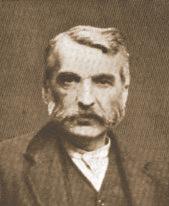
Robert Anderson’s memoirs discuss the case in detail, and mention an unnamed suspect simply described as a ‘Polish Jew’. Anderson wrote that the only witness who ever got a close look at Jack the Ripper, had identified this suspect immediately, but then

refused to testify in court. While reading this memoir, however, Swanson decided to make his own note in pencil on the page. The note is tantalising, not only because it names the suspect, but suggests that Swanson – a contemporary authority on the Ripper case –believed this suspect to be the true culprit: “... after this identification – which [the] suspect knew – no other murder of this kind took place in London… he knew he was identified. On [the] suspect’s return to… Whitechapel, he was watched by
police (City CID) by day & night”. Swanson finishes his note: “Kosminski was the suspect – DSS” [Donald S. Swanson].

Kosminski is thought to be Aaron Kosminski, a barber, who was indeed a Polish Jew. Swanson believed that the eyewitness refused to testify, knowing that Kosminski would be hanged, and not wanting a death on his conscience. But it seems that Swanson was of the opinion that Kosminski was the elusive Jack the Ripper. Some researchers today refute this theory. But given that the Ripper case has never been satisfactorily solved, the opinion of a lead detective – especially one of Swanson’s intellect – who knew the evidence back to front, must count for something.
When it comes to Swanson’s last great case, there was an interesting final act. Gainsborough’s “Georgiana, Duchess of Devonshire” was sold upon its return to England to the banker J.P. Morgan, and remained in the Morgan family until 1994. That year it was put up for auction at Sotheby’s where, very fittingly, Chatsworth took the opportunity to buy the portrait back. It was finally returned to its original home after more than 160 years! Recently, the archive of the great London detective Donald Swanson, who was instrumental in getting the portrait back, was entrusted to a Sheffield museum just 40 minutes drive away from that very painting.
Editor’s Note: The Swanson Marginalia is on display as part of the “Daring Detectives & Dastardly Deeds” exhibition at the National Emergency Services Museum, West Bar, Sheffield S3 8PT. The museum is the 2022 winner of the UK’s Family-friendly Museum Award.
Left: The ‘Swanson Marginalia’ – Swanson’s copy of the former Met Assistant Commissioner Robert Anderson’s memoirs, which discuss the Jack the Ripper case in detail, and with notes by Swanson in the margins and at the bottom of pages. The book is on display at the museum in Sheffield. Courtesy National Emergency Services Museum.


THE Chesterfield Canal Trust will hold its annual festival at Staveley Town Basin, S43 3XZ, on Saturday and Sunday, June 24 and 25, from 10am-5pm each day. Admission will be £6 (under-16s admitted free).
There will be free parking nearby, with parking for the disabled onsite. The whole site is accessible to wheelchairs.
All four of the Trust’s tripboats will be in action; two of them have wheelchair lifts. Pleasley Vale Canoe & Activity Club will be running canoeing sessions; and children will be able to ‘have a go’ on a mini-digger.
Free entertainment will include music, dance and street theatre, both in the big marquee and outside by the lock.
The Trust’s development manager will be holding Q&A sessions in the marquee about the plans for the restoration of the canal.
In addition, there will be birds of prey, children’s rides, water walking balls, bumper boats, spinning bumper carz, Newfoundland rescue dogs, face painting, craft stalls, charity stalls, lots of food stalls and a real ale bar.
There will be separate concerts on the Friday and Saturday nights, starting at 7.30pm. Friday will see the return of the ever-popular Swing Commanders, while Saturday will feature Chesterfield’s own WonderWhys. Tickets for both concerts are available from the Chesterfield Canal Trust website. There will be onsite parking, food stalls and a real ale bar.
On Monday, June 26, there will be a flotilla of all four trip boats from Staveley Basin right up the canal to Tapton and back, with stops at Hollingwood Hub and Tapton Lock, covering 10 miles and 12 locks.
On Tuesday, June 27, there will be a What, Where and When Restoration Walk to show how the canal looks before the major restoration works start next year.
Email festival@chesterfield-canaltrust.org.uk or ring 01246 477569 for further information, or if you would like to have a stall or bring a boat.
THE Peak District Bird of Prey Initiative is to close, with differing views among the group’s stakeholders and continued cases of persecution leading to the initiative ‘no longer being able to deliver meaningful change’, according to the National Park Authority, convenors of the initiative.
Set up in 2011 by the National Park Authority, the initiative’s goal was for populations of the region’s key birds of prey to be returned to levels last seen during the 1990s, and the re-establishment of hen harrier as a regularly breeding species.
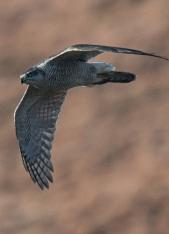
The Peak District has historically been home to populations of iconic species such as the peregrine, goshawk, merlin – the UK’s smallest raptor –and the hen harrier, one of the most persecuted birds of prey in the country. A supporting cast of other raptors includes the short-eared owl, with increasing sightings of red kites and ospreys.
Despite more than a decade of the initiative, which included representatives from the landowning and gamekeeping community, conservation groups, the police and other bodies, populations of many of the key species have not increased at the
rates initially hoped for, with some seeing no improvement at all. Whilst hen harriers have returned to the area, successful breeding currently remains limited.
Those involved in the annual surveying of raptors within the study area – largely comprising the Dark Peak uplands – have stated they no longer felt they could continue supporting the group. The RSPB stepped down as a member of the initiative in 2018.
Although progress has been seen with some species, including the goshawk, direct persecution has remained a factor. Incidents of shooting, poisoning, trapping, nest destruction have featured every year of the initiative’s monitoring.
The National Park Authority believes that until these illegal activities are tackled, meaningful progress towards population increases will not be possible.
Phil Mulligan, chief executive of the Peak District National Park Authority, said: “It is with regret that we are closing the initiative after more than a decade of endeavours to safeguard our charismatic birds of prey.
“The fact that the work of the initiative has failed to reflect those target populations of some 30 years ago remains a cause for real concern, and it is without question that illegal persecution targeted towards some of these species is one factor behind this stuttering progress.
“We must now look at alternative ways to ensure our birds of prey have a future in the Peak District, free from the risk of illegal actions.”
The authority has confirmed that it will continue working with a range of local stakeholders and potential activities will be outlined as part of the authority’s ‘Nature Recovery Plan’, due to be released this summer.



A SHORT video and a book have been launched by Derbyshire County Council (DCC) to celebrate the Walking Together Mining Memorial project, telling its story and giving fresh insights.

Walking Together is a memorial trail at Markham Vale Business Park – the former Markham Colliery area. The trail commemorates the 106 miners who lost their lives in the three major disasters at Markham Colliery in 1937, 1938 and 1973, with a sculptural steel figure for each one. Figures have been gradually added over the last decade, and was completed last October.
The project has been led by Derbyshire County Council, HBD (formerly known as Henry Boot Developments) and Markham Vale Heritage Group volunteers, coordinated by Beam (an arts charity) and enabled by many sponsors and supporters.
Artist Stephen Broadbent developed the concept with guidance from the local community. The route symbolises a miner’s journey to the pit and back home again. Each figure bears a tag with the name of the miner, his age, occupation and the year of the disaster.
The new Walking Together book shares creative writing, stories and artwork inspired by Markham’s mining heritage and is available to borrow from Derbyshire’s libraries. It is also available as an online downloadable version that can be found on the Story Mine website at markhamstorymine. org along with the video.
County Councillor Tony King said: “I have been involved in this wonderful, poignant project for over six years. Those
involved feel like old friends and it’s thanks to the dedication of the Markham Vale Heritage Group that we now have this excellent book and video to share.”
The book and video are supported by the National Lottery Heritage Fund, who have been involved in the project throughout.
GREEN-FINGERED residents are being encouraged to show off their talents in this year’s Chesterfield In Bloom competitions.
Chris Turner, chair of the Chesterfield in Bloom committee, said: “Last year, not only did we win on a regional level but we also received lots of fantastic entries for our Chesterfield In Bloom competitions. The standard was exceptional.
“Please get your entries in as soon as possible and I wish everyone the best of luck.”
People have until June 16 to submit their entries or to nominate their neighbours in the following categories: Best Front Garden, Best Back Garden up to 80 sq m, Best Back Garden larger than 80 sq m, Best Container Garden, Best Blooming Pub/Restaurant, Best Allotment (with sub-categories based on size).
There is also an exclusive competition for council tenants, and entries are invited for Best Garden (either front or back) and Best Containers.
Residents can only enter two categories but everyone who takes part is automatically
BREAST Cancer Now’s Pink Ribbon Walk events are back this summer and I want to encourage your readers to step forward and sign up for the 10 or 20-mile walks.
I know just how vital research and support is for those affected. My mum died from breast cancer. Then, three years later, I was given the devastating news – I had breast cancer in both breasts. Now, after gruelling treatment, I’m glad to say, it’s been 10 years since I was told I had no evidence of disease.
But I still worry for my daughter and future generations of women and men, which is why I’m taking on a 20-mile Pink Ribbon Walk this summer. This year will be my fifth Pink Ribbon Walk and every time I cross that finish line it feels incredible.
Breast cancer is the most common cancer in the UK. Every 10 minutes, someone in the UK hears the words “you have breast cancer”.
Breast Cancer Now are moving towards a vision that by 2050, everyone diagnosed with breast cancer lives, and is supported to live well. Pink Ribbon Walk events make this possible by raising money for world-class research and life-changing support services.
Join me at a Pink Ribbon Walk this summer. Sign up today at breastcancernow.org/ ribbonwalk to provide support for today and hope for the future.
Jane Atkinson
Breast Cancer Now Pink Ribbon Walk fundraiser
Editor’s Note: There is a 10 or 20-mile Pink Ribbon Walk at Chatsworth House on Saturday, July 8. You must be over-16 to register for this event, and the fee is £20.

entered for the Best Overall Garden judging. The ever-popular schools’ competition makes a return this year, too.
Entry forms are available on the council’s website: www.chesterfield.gov.uk/bloom
For more information, email bloom@ chesterfield.gov.uk or call 01246 959416.



MANY include becoming an author on their bucket lists, but their hopes get squashed by how difficult it seems. Researching, telling a story, and conveying ideas seem like a challenge in its own right. But, once the book is written, how and where do you find a publisher.

Self-publishing can be hugely rewarding. The author retains ultimate control of every step of the publishing process in a way that couldn’t be achieved with a traditional publisher. Choosing a trusted and experienced publishing house presents the perfect opportunity to combine autonomy as an author with publisher expertise. North Derbyshire-based, Bannister Publications, is a highly regarded regional publishing institution. There are many reasons why they’ve become the publishing partner of choice for local authors:
Local network: 30-year experience of publishing has enabled strong and longstanding local connections to be built
Reputation: as the publishers of Derbyshire’s largest circulation
lifestyle magazine Reflections, Bannister Publications offers a well-established platform that can help to promote the book.
Breadth of experience: a comprehensive portfolio of writers, authors, photographers, artists, and others, all with varying levels of experience, have been supported in getting their work published in a professional manner, in a variety of finished book forms.
Personal service: displaying all the hallmarks of a highly reputable familyrun business, Bannister Publications prides itself on offering a friendly and attentive service. From initial discussions to the final printing of the book, Robert Bannister, guides authors along their journey every step of the way.
Quality: the editing and design services are unrivalled locally, and the printers, who are used, serve the UK’s major publishing houses.
Value for money: Runs of small books at comparatively low prices are easily attainable – as are longer run bigger and more intricate publications.
The first step to publishing a book starts here…
Bannister Publications Limited
118 Saltergate Chesterfield
Derbyshire
S40 1NG
hello@bannisterpublications.com
T: 01246 550488





WHEN a colleague spent a brief, but painful, spell in Chesterfield’s Royal Hospital, she was amazed at the effect of an unexpected visit.
“Two beautiful dogs appeared on the ward – and suddenly the whole atmosphere changed,” she recalls. “The ward seemed to ‘light up’ when they entered. It was really incredible how they lifted everyone’s mood.”
They were therapy dogs Sumi and Koji, regulars at the hospital alongside their owners Bev and Steve Deighton, from Bolsover.
Bev and Steve have worked with therapy dogs for 15 years, beginning with their first Japanese Akita, Kendo.

Sadly, Sumi passed away in November last year – just a day after her final ‘shift’ at
the hospital. But the legacy of both Kendo and Sumi is carried on by three-year-old Koji, who visits the Royal three mornings each week.
Bev explains: “Japanese Akitas were originally bred for looking after children and families, so they have a very nurturing nature. They are naturally laid back. At

the hospital, Koji knows he’s working. As soon as the coat goes on, he’s at work.
“There are three areas he particularly excels in – ITU, HDU and end-of-life but, like Kendo and Sumi, he has also played a part in patients’ recovery. We build relationships with long-term patients –sometimes following their progress from ITU to recovery and staying in touch.
“One is Dan, who had a condition which caused paralysis. He credits Sumi and Koji with giving him the determination to get better. Another is a girl who had anorexia. She was very sick when we first
Left: The Deighton’s first ‘therapy dog’, the Japanese Akita called Kendo, who visited the hospital many times in his life.Fiona Stubbs discovers how therapy dogs bring comfort, support and inspiration to hospital patients – and staff
met her and has since said that the only thing that kept her going was our visits. She is now well and still keeps in touch.”
Bev and Steve work under the charity Canine Concern and are assessors for other therapy dogs. Valerie Fillery, CEO of Canine Concern, says: “Who could resist a gentle, caring, happy and very intuitive Japanese Akita? Bev and Steve with their caring, funloving Akitas have been a great team and nothing is too much for them. We are very lucky to have them as part of the charity. These wonderful stories really help make my job as the CEO a very happy, satisfying one.”
Bev and Steve describe their journey as a ‘happy accident’ – beginning when they adopted Kendo from their daughter, because she was unable to keep him.
Bev explains: “We had friends with a young boy who had complex needs. We stayed with them sometimes and the bond that developed between him and Kendo was something else. If he woke up, crying, in the middle of the night, Kendo was immediately by his bed. It made us realise there was far more to Kendo.”
They initially began working through the charity Pets As Therapy, first with visits to Bolsover hospital and then extending Kendo’s influence to a primary school, where children who were struggling to read would practise reading to him.
From there, they ventured into care homes, brain injury and personality disorder units and worked with charity Mencap, then with dementia and Alzheimer’s patients at Walton Hospital. They have been visiting Chesterfield Royal Hospital, at Calow, for six-and-a-half years.
Hannah Peate, Health and Wellbeing Lead, says: “We are delighted that Koji, Beverley and Steve are part of our health
“BEFORE I met Bev and Steve, my lengthy stay in Chesterfield hospital was pretty dull. Due to the condition I was in, I was unable to move from my bed and was staring at the same four walls and having the same conversations day in, day out. So my morale was pretty low.
and wellbeing team. They are welcome faces around the Trust and Koji is always putting a smile on the faces of colleagues. There is a known benefit to having therapy dogs in hospitals and we are incredibly grateful for the work that #TeamKoji do around our wards and teams.”
As well as visiting patients, Bev and Steve hand out pictures of the dogs for them to keep and many also follow the Sumi Kendo Koji Facebook page (https://www. facebook.com/sumi.kendo/)
Kendo died, aged 13, after 10 years of working in the NHS and Sumi achieved nine-and-a-half years of therapy work.
“When Kendo passed away, we had 1,500 responses on Facebook,” says Steve. “When we lost Sumi, there were 2,000 responses. It shows just what an impact the dogs have on people’s lives.”
The Covid pandemic and lockdowns disrupted the therapy work – but, as restrictions eased, there was a new role to play supporting exhausted staff at the Royal.
Steve remembers: “In December 2020, Sumi and Koji were invited back once a week. Staff were able to spend a bit of time with the dogs, which was a huge benefit because they were under so much pressure.

“Covid changed our focus and now we get asked to attend all sorts of events in the hospital – leaving parties, birthdays… you name it! Koji was just starting out then but he had Sumi as a role model. He learned a lot from her.”
“I remember, just before I met them, I was on the phone to my wife and I could hear the lovable Koji barking away. I thought to myself there was no way this could be and I must have been hearing things – or someone was walking a dog outside as my ward looked out onto a field.
“But as soon as I put the phone down, I saw two beautiful Akita Inu trot into the room and my whole mood went up.

“I got talking to Bev and Steve and thanked them for bringing Sumi and Koji onto the ward as I’ve always loved dogs. They asked if I would like to see them on a weekly basis and I instantly said yes. It gave me something to look forward to each week and was a welcome change to the dull life of being stuck in a hospital bed.
“I owe them so much as seeing them every week really helped with my mental health and also gave me the strength and determination to get better. I also believe that I have made friends for life as, even when I was discharged from hospital, they still made time for me to see the dogs before my physio appointments.
“I’m still in contact with them and we have met up outside of hospital conditions – which was great. I honestly believe that they were crucial to my recovery mentally – and for that I will forever be grateful.”
Above inset: Koji ready for his next hospital shift.“Who could resist a gentle, caring, happy and very intuitive Japanese Akita?”
Koji now visits the hospital on Monday, Wednesday and Friday mornings – not only brightening the mood of patients but also medical, office and support staff.
“Just five to 10 minutes of cuddles and play make a big difference to busy, stressful working days,” smiles Bev. “Koji lightens their day. He walks onto a ward and even doctors and consultants will say ‘I need Koji today!’ You can see the pressure lift from them.”
The benefits for patients vary – from the immediate tactile comfort of stroking Koji’s fur to the memories it evokes.


Bev explains: “I think that, for the older patients, it brings back memories of dogs they’ve had in the past and, for long-stay patients, it helps if they are missing their own pets.”
Steve adds: “There are regularly tears from people who can’t see their own dogs. If we know someone is going to be in hospital for a long time, we’ll visit them more often. It’s like a big extended family for us now.
“We’ve built up a rapport with people from a work and personal basis. We get into all sorts of conversations. Some people are unable to speak, but they smile when they see Koji. It might be the only time during the day that they have a reason to smile.
“He also knows there are stashes
of biscuits all over the hospital –and he knows where to look!”
The hospital has dedicated night staff who never see Koji on his usual visits, so Bev and Steve make occasional evening trips.
Koji, like Kendo and Sumi before him, is drawn – through a powerful sense of smell – to those who need him most and sometimes the results are extraordinary.
Bev reveals: “One day, a consultant asked us to see a patient who had high blood pressure, which they just couldn’t get down. We went in and, as the patient stroked Koji, we saw the numbers on the monitor steadily coming down.”
For Bev and Steve, the hospital visits are a labour of love.
Steve says: “People ask why we do it and we say ‘because we can’. I’ve been treated over the years by the NHS and this is a way of giving back.”
Bev adds: “I enjoy it as much as I did 15 years ago. It’s seeing people’s faces, realising what a difference you can make. And sometimes a patient will open up to you because you are an outsider. In a nutshell, as much as we are doing therapy, it’s also therapy for us. It puts life into perspective, in some respects.
we were a bit lost – the hospital visits are a big part of our lives. But the break also gave us time to work with Koji who was a puppy and who has turned out to be perfect at what he does.”
Koji checks out an ECG chart.

BARN Farm Campsite is located in the village of Birchover, close to Stanton Moor. Over the years the campsite has won various awards and in 2022 was the winner of Best Campsite, East Midlands and runner up of Best Campsite in the UK (out of 800 sites).
Guests delight in the site’s friendly atmosphere and rural location and can also enjoy the company of the peacocks and alpacas based on site.
The campsite also has strong links with The Duke of Edinburgh Awards Scheme and organisers return year after year to their own camping area.
This summer – starting on the Coronation weekend in May – Barn Farm will be supported by volunteers of local charities Ashgate Hospice and Helen’s Trust, who will be serving refreshments and hosting various stalls at the campsite, to raise money. A volunteer will also be on site representing the Anthony Nolan Cancer Charity.

If you would like to become a volunteer to help the charities at Barn Farm, or volunteer in general, get in touch with the relevant charity: Ashgate Hospice, call 01246 567250 or email communityfr@ashgatehospicecare.org. uk; Helen’s Trust, call 01298 815388 and ask to speak to The Volunteer Department.
ACROSS England, the average asking price of a beach hut is currently £49,290, having increased by 43 per cent over the last 12 months. And in Dorset’s seaside towns, it has actually doubled to a whopping £123,524.
In contrast, the average price of a bricks-and-mortar home nationally, according to the property website Zoopla, has risen just four per cent over the last 12 months. But Derbyshire sellers have fared slightly better, with the average property price increasing by six per cent over the last 12 months. The average property price in Derbyshire is now £245,000.



Well dressings are an ancient custom found throughout Derbyshire and the Peak District. Using just basic and naturally sourced materials, intricate works of art are created drawing visitors from near and far, as Catherine Roth reports.
WIRKSWORTH holds its annual well dressing in May, continuing a tradition that can be traced back to the early 19th century. When the tradition began in Wirksworth, it wasn’t wells that were dressed but the taps that provided piped water to the town.

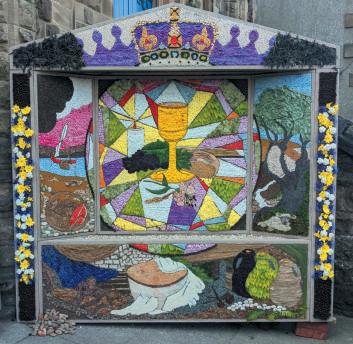
Sue Gratton, the assistant clerk at Wirksworth Town Council which is responsible, along with a small Well Dressing committee, for organising the
event, says: “The origins of the well dressings are uncertain but it is said that the custom was first adopted in Wirksworth to celebrate the arrival of piped water to the town in 1827 when the taps were dressed and known as ‘Tap Dressing’.”
However, the origin of well dressings in Derbyshire generally goes back much further in time and is believed to have its roots in paganism, when people would give thanks to the water gods. Sue
adds: “The practise is thought to have originated with the Celts, but early Christians disapproved of it since they perceived it as water worship and it was quickly put to an end. Nevertheless, the tradition refused to die. Tissington was the first village to re-introduce well dressings around 1349 after the village managed to escape a terrible outbreak of the Black Death that swept through England during this time.”
Whether it was wells or
taps, the reason behind the well dressings remained the same – to give thanks for the continual supply of water.
Traditionally, many of these floral tableaus depicted scenes from the Bible, although Sue explains that the current trend is one of a topical theme. For example, previous well dressings in Wirksworth have included 100 years of the suffragettes in 2018; the world scout Jamboree in 2019; the Rugby World
Cup; the first man landing on the moon; and the RAF.
The well dressings begin as wooden boards and a large lump of clay; and a variety of natural materials, including petals, all need to be collected before being transformed into pieces of art. Sue says: “Well dressings come in a variety of sizes but the construction is always the same, a wooden panel is soaked in water before being covered in clay and smoothed flat – known as puddling.” The clay is donated by Spencer Bros, a family-run company based just a few miles away in the village of Brassington.
Sue adds: “Once the design has been chosen, it is traced onto the well dressing foundation structure that has already had the layer of clay applied. Then the delicate art of placing petals, seeds, bark, etc, is applied to form the finished piece of art.”
Petals bring vibrant colour to the well dressings while other traditional materials used include berries, leaves, twigs, straw, hay, moss and feathers. Items can also be used that one would more usually expect to find in the food cupboard, such as rice, dried pasta and coffee beans. Last year, to celebrate Queen Elizabeth II’s Platinum Jubilee, eggshells were used in one well dressing to depict the monarch’s face.
The boards vary in size and many hours are spent
bringing the intricacies of the designs to life, often with numerous people from the community getting involved. The many people involved in creating the well dressings are often volunteers from a local charity or church group, or whole classes of students.
Sue says: “The process takes approximately six days before the well is carefully transferred to its display position around the town. The well dressings are a great celebration of the community coming together.”
The well dressings are all sited in the centre of the town, including by the Cruck Beam, the remains of a medieval house; in the memorial gardens; at St Mary’s Church; and outside the aptly-named
Wellspring Church, as an old well lies beneath it. In fact, it is thought that the location of the well dressings in Wirksworth may be on sites where the original wells once were.
The event this year begins on Saturday, May 27 when the blessing of the wells ceremony takes place. Starting outside the Wellspring Church and finishing at the United Reformed Church, the ceremony is led by a member of the local clergy who goes round blessing each of the wells, accompanied by music from the BM&W (Brassington, Middleton and Wirksworth) Brass Band. The wells then remain in situ until the following Wednesday or Thursday.
The best time to visit is inevitably during the first
weekend when the wells will be at their best before the petals and other material begin to wilt. While this makes the well dressings a short-lived event, this transience is arguably part of its appeal in today’s world – the choice of materials dependent on what is currently flowering and in season and a product that isn’t artificially prolonged by chemicals.
In fact, the well dressings have little to no impact on the environment as the boards are reused from one year to the next, the clay can also be recycled whilst the leaves, petals and other decorations will naturally biodegrade.

Today, the tradition in Wirksworth is kept alive by the Town Council and the
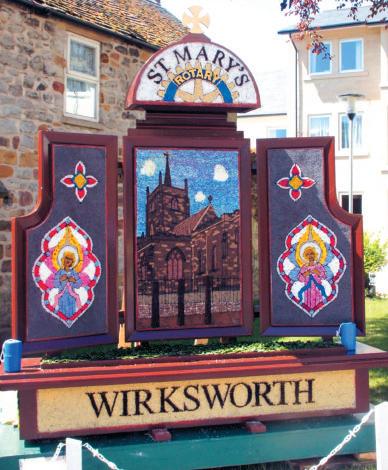
many volunteers. Sue, who is responsible for all the associated administration, is supported by a committee of five as well as numerous helpers who act as marshals at the blessing of the wells ceremony on the first day. As well as attracting visitors to the town, the well dressings have helped to raise thousands of pounds for both local and national charities over the years.
This year there will be 12 wells to visit and a trip to see them all provides an opportunity for visitors to discover more about this historic market town. Explore the Puzzle Gardens with its maze-like network of jitties, visit the Wirksworth Heritage Centre to find out about the lead mining industry the town was built upon, step back in time at Wirksworth station and journey by steam train along the Ecclesbourne Valley Railway, or simply stroll along the main street and enjoy the range of independent shops and eateries. There is so much evidence of
history in Wirksworth and the well dressings also offer a portal to the past thanks to this ancient tradition being kept alive.

Derbyshire Well Dressings schedule: There are many well dressings to visit in Derbyshire from now until September.

Some even offer visitors the opportunity to see the well dressings being decorated before the main event.
Here are some of the well dressings coming up in Derbyshire in May and June: Tissington (May 18-24); Monyash (May 27-June 3); Middleton-by-Youlgrave (May 27-28); Ashford-in-the-Water (June 3-11); Swanwick (June 10-18); Cressbrook (June 1117); Litton (June 17-24); Over Haddon (June 17-25); Tideswell (June 17-25); Youlgrave (June 24-29); Rowsley (June 24-July 1); Hope (June 24-July 2); and Bakewell (June 25-July 2).

For further details, as well as dates of other well dressings taking place across the county, visit www.visitpeakdistrict. com or welldressing.com
Tissington was the first village to re-introduce well dressings around 1349 after the village managed to escape an outbreak of the Black Death. Here’s an image of one of the village’s six wells dressed for the Queen’s Diamond Jubilee in 2012.








THE practice of twinning towns became popular in the years that followed World War Two, when it was seen as paramount to keeping the peace to foster international relations by means of bringing towns or villages together. The reasoning was that once communities could learn to see each other through the lenses of individual people and families, then war was sure to be discouraged in the future.
Chesterfield is happily twinned with four different settlements across the world. The earliest twinning came into existence in 1959 when Chesterfield was twinned with Darmstadt, in Germany; then Troyes in the beautiful Champagne region of France followed in 1973; with the international family welcoming the new arrivals of China’s
Yangquan in 1987; and Namibia’s Tsumeb most recently in 1993.
Just as Chesterfield oozes with heritage, its German sibling Darmstadt also boasts a rich history and culture. A city in the state of Hesse, one of the best known castles in the region is Frankenstein Castle, which lays claim to having influenced the titular character’s name in Mary Shelley’s novel. The connection between the author and this German castle is not without foundation, owing to the fact that Shelley was known to have visited the region whilst a teenager.
This year, Troyes and
When it comes to twin towns, Derbyshire has many fascinating pairings. Here are a handful of local settlements with exotic continental cousins, writes Mica Bale.Mathildenhoehe in Darmstadt, Chesterfield’s twin town, is one of the most celebrated examples of Art Nouveau style architecture in Germany. This colourful ensemble comprises a wedding tower (Hochszeitsturm), a Russian chapel, a lily basin and an art exhibition hall. Right: The Arctic village of Chesterfield Inlet in northern Canada. Above: The beautiful town of Troyes in the Champagne region of France. It is 50 years since Troyes and Chesterfield first twinned.
Chesterfield celebrate fifty years of twinning. Troyes is in an historically important area in the Champagne region, and you can expect to see locally sourced varieties of cheese, fine wine and Andouillette – a special French sausage made from pork including the colon – making it a local delicacy that visitors may need a little convincing to try!
Shanxi Province has a long-established twinning relationship with Derbyshire. At the time the link was formed, both Chesterfield and Yangquan were coal-mining centres.
Interestingly, the town is not twinned with any of the other 21 settlements bearing the name Chesterfield – not to mention the uninhabited Chesterfield Islands in the Pacific Ocean. There are an astonishing 16 towns in the USA with the name; three settlements in Jamaica; an Arctic village called Chesterfield Inlet in the Canadian province of Nunavut; and the southernmost Chesterfield in the world is on the west coast of New Zealand’s South Island.
One of the American towns – Chesterfield in Virginia – is twinned with the town of Gravesend (located in Gravesham Borough, Kent), as both have links to Pocahontas, the daughter of Indian chief Powhatan and the wife of John Rolfe.
In 1617, Pocahontas, a native of what would one day become Chesterfield County in Virginia, visited England with her
husband. However, she became ill and died during her visit; and is buried in Gravesend.
Just as Matlock also boasts a rich spa heritage, so too does its twin in central France, just a few miles from Paris. Twinned in 1992, there are annual exchanges between residents of Matlock and Eaubonne and lots of opportunities to make friends through wine tastings, meals and a good game or three of boules.
Wirksworth can boast being one of triplets with Die in France and Frankenau in Germany. Twinned with each European sibling for decades, Die –pronounced Dee – is located in southern France and is especially renowned for its sparkling wine, Clairette de Die. Reportedly, the sparkling white wine owes its existence to a humble shepherd who stumbled across a natural spring and utilised it to keep his bottle of wine cold, which then was promptly forgotten about in the winter.
In spring, the bottle was reportedly rediscovered and it was found to be sparkling – thus inventing this delightful drink.
Germany’s Frankenau is a town that was nearly completely destroyed in the mid-19th Century following a devastating fire. Through the determination of
its people, Frankenau rebuilt itself and is now a thriving settlement that is renowned for drawing in tourists.

Joined together with Dronfield in 1971, Sindelfingen is a city in southern Germany that boasts

a special connection to cars. From the early 20th century, Sindelfingen’s story became entwined around one of the biggest car manufacturers in the world – Mercedes-Benz – when a factory was built in the city in 1915. Originally built with a runway owing to it initially being a centre for manufacturing aircraft engines. In the years that followed World War One, cars were being produced from Dronfield’s twin. In fact, the first car with an internal combustion engine was created by Karl Benz and patented way back in 1886. Certainly our towns and their continental cousins are enriched by the interaction. After all, twins certainly bring twice the spice!
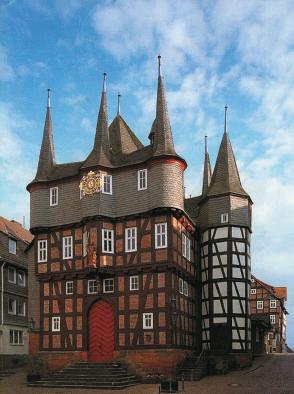 Frankenau, a popular tourist town in Germany, is twinned with Wirksworth.
Frankenau, a popular tourist town in Germany, is twinned with Wirksworth.


As temperatures start to rise, so do hemlines – meaning it’s time to give your wardrobe a short and sweet update, says Amy Norbury. From tailored Bermudas to chic co-ords, shorts are a go-to for summer style.


The sweet sound of summer is almost upon us, bringing with it a whole raft of updates for your wardrobe. As the mercury starts to rise, so do the hemlines – and pins which have barely seen the light of day in months get ready to make an appearance.
Shorts have been having a fashion moment for many a season as we’ve cycled (ahem!) through trusty denim cut-offs and the shortest of hotpants, to skintight lycra bike shorts and more modest tailored affairs.
And for 2023, the shorts story is one of opposites...
At one end of the spectrum, those short-shorts are making a comeback, as championed by Miu Miu and their
1. Addison top, £44.95, and Darla shorts, £59.95, Barbour. Available from www.barbour.com

2. V&A Love and Roses relaxed double breasted blazer, £62, and high waisted button tab shorts, £32, Lipsy.
3. Tally embroidered blouse, £55, and Mom shorts, £42, FatFace. www.fatface.com
ADORN Jewellers of Chesterfield has decided it’s time for a right royal celebration as the nation comes together for their Majesties King Charles III and the Queen Consort’s Coronation on Saturday 6th May 2023.
As excitement grows for the upcoming coronation, Adorn’s owners, Laura Jo and Adam Owen, are pulling out all the stops to mark the occasion in regal style. With costumes fit for a king, a sparkling competition, the expected royal treatment, bunting galore, and a special coronation tea, they are certainly encapsulating the ‘feel good’ factor and entering into the spirit of these noble celebrations.
Laura Jo has commissioned a special Coronation dress from ‘Bella Figura’ in Matlock, whilst Adam will be sporting a stunning regal-themed waistcoat courtesy of Esberger Fabrics. And the two dogs, Heathcliff and Moriarty, are getting in on the act as well with matching bandanas!
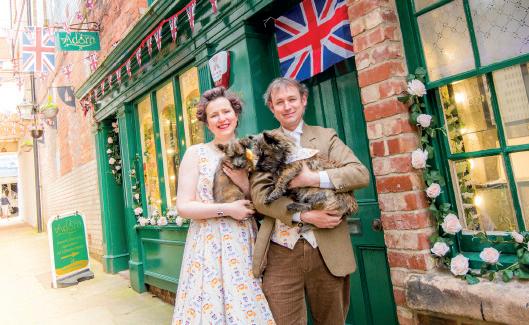
During the week leading up to this momentous historic occasion, Adorn’s
customers can expect the merrymaking and jollification to be in full swing. On the Monday, Thursday, Friday, and Saturday, the owners, in full dress, will be offering a free cup of Coronation tea, specially blended by ‘Cup and Saucer’, to all visitors. There will also be a free prize draw to win a silver bangle featuring the Coronation hallmark. This prize has special significance, as it will ever remain an historical keepsake and heirloom, as it has been uniquely struck for the year of the Coronation.
Having opened its doors in the Middle Shambles in the heart of Chesterfield town centre on November 25th, 2010, Adorn Jewellers has been described as a ‘Jewel in the Crown’ amidst the wonderful array of superb independent shops in Chesterfield.
Showcasing a beautifully eclectic collection of quirky, bespoke, distinctive, original, and bohemian jewellery, Adorn has built its reputation on providing something completely different from anywhere else on the High Street.
Adorn has carefully selected and curated unusual jewellery by independent designers from all around the country. Promoting and
supporting exciting, intricate, and innovative design talent, they have assembled a sublime choice of one-of-a-kind pieces that blur the boundaries between art, fashion, and culture.
With over a thousand pieces now available, Adorn Jewellers offers a stunning selection of jewellery, which includes one-off romantic items, beautiful hand-set semi-precious stones, such as emerald, sapphire and ruby, handcrafted silver jewellery and a marvellous collection of wedding, engagement and proposal rings in gold, palladium, and platinum. Independent artisan suppliers are sourced from even farther away these days with some pieces now emanating from Europe, America, and India.
Customers visiting Adorn Jewellers in the run up to the Coronation can expect to see many new pieces of jewellery instore. Locally sourced Blue John, emerald, ruby, aquamarine, canary yellow diamond, and amber jewellery collections are now prominent amongst the beautiful displays. Come and enjoy the regal revelries at Adorn Jewellers – definitely an experience not to be missed!
barely-there numbers across the SS23 catwalks. But if your hotpants days are behind you, at the other end, looser and longer styles are leading the way for wearable style.
One of the season’s hottest cuts is straight out of the movies. Inspired by Julia Roberts’ classic salmon Bermuda shortsand-blazer combo in Pretty Woman, Bermuda shorts are top of the list for easy, breezy style. High-waisted and belted preferably, pair with a loose-fitting blouse or cami and a matching blazer for boardroom-to-bar chic.
Speaking of matchy-matchy, co-ords are showing no signs of slowing down their fashion trajectory. Spring’s love of suiting continues apace, with tailored shorts suits offering the perfect take on all-occasions dressing. Team with a shirt and sandals for a smarter smart-casual vibe, or dress down with a T-shirt and trainers.

Away from suiting co-ords, take on a more casual approach, with floaty shirts and bold patterns offering a relaxed holiday feel whether you’re at home or away. Top picks include LMND’s cotton poplin Chiara shorts, with their ‘borrowed-from-the-boys’ boxer style and co-ordinating loose fitting shirt which makes light work of summer dressing.





Trusty denim is always going to have a say when it comes to your shorts arsenal, and every wardrobe should have at least one pair. Following on from the all-encompassing ‘mom’ jeans trend, ‘mom’ shorts are the way to go for a flattering fit which marries comfort with style. And what more could you want?


Name: .....................................................
Address: ..................................................
Telephone:
We will give a prize of £25 to a randomly-drawn correctly completed crossword. Cut out the completed puzzle and send to: Bannister Publications, 118 Saltergate, Chesterfield S40 1NG by the 22nd May 2023. The solutions for the April 2023 crossword can be found on page 81 of this issue.

More free puzzles at pitcherwits.co.uk
Crossword by Prof Rebus

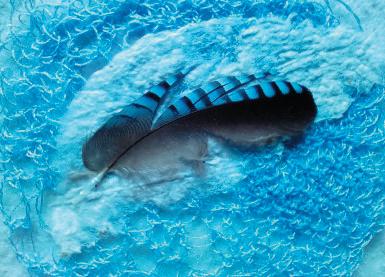
DERBYSHIRE Open Arts promotes an annual art event over the Spring Bank Holiday weekend, this year on May 2729 inclusive. Artists and crafts people open their studios to the public or exhibit with others in venues such as a village hall or art
Saturday, Sunday, Monday: 10am-5pm each day.
ECOSTITCHERS is a group of textile artists in Derbyshire. Each member of Ecostitchers works independently, inspired by a theme chosen for the year, and for 2023, the theme is ‘No Rain, No Flowers’. This new exhibition will have its premiere in the village hall as part of the Derbyshire Open Arts Festival. Members of Ecostitchers taking part include Jan Novitzky, who uses a variety of techniques including hand and machine embroidery; and Liza Smeeton, who uses both hand and machine embroidery and likes to include beads, buttons and other objects where she can.
gallery. It gives visitors an opportunity to see the breadth of art that is created in Derbyshire – with over 200 artists and craftspeople taking part – to meet the creators, and to purchase or commission works. Derbyshire Open Arts continues to be
funded entirely by artists’ subscriptions and is run by volunteers. Full details of the artists taking part, and all the venues, are on the website derbyshireopenarts.co.uk Here are a few ideas on where you might visit…
Above: Two ceramic owls, with the distinctive use of gold leaf, by Vivienne SIllar (Haddon Hall Gatehouse).
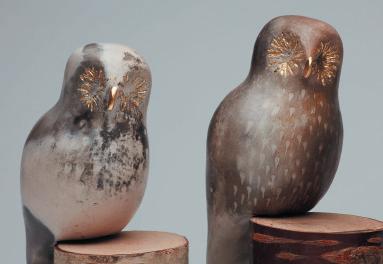
Left: This Jan Novitzky work is part of the Ecostitchers exhibition at the Cavendish Village Hall, Beeley.
There is also Maria Newman, whose art uses a variety of techniques including fabric piecing, printing, painting and applique, with fine detail being added through machine and hand embroidery; and Jude Shore, a textile artist and fine felt maker who is using issues of climate change to explore their 2023 theme to showcase an exciting body of innovative textile art. Also exhibiting at the village hall is Allison James, an art quilter who makes wall hangings and textile art inspired by both the natural and built environment. Allison is a member of a new international exhibiting group of art quilters – 20perspectives.
Saturday, Sunday, Monday, 10am-5pm each day
FIVE members of Peak District Artisans will be exhibiting at the Gatehouse Gallery: hand-stitcher Alison Wake, ceramicist Vivienne Sillar, lino print artist Lottie Adams and painters Roger Allen and Sarah Joseph. Roger Allen works in watercolour and oils, and has exhibited at the Royal Academy Summer Exhibition, Royal Watercolour Society Open, Sunday Times Watercolour Exhibition and has paintings in the collection of Derbyshire County Council. Sarah Joseph is a Trinidadian painter who has been exhibiting consistently for over 25 years in her home country as well as further afield. She finds that the drastic change of environment that came from moving to the UK in 2019 has energised her work. The different type of flora and fauna and even the different quality of light, have all influenced her work in a significant way.
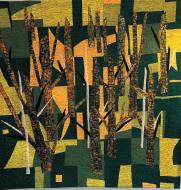
Lottie Adams has been a lino print artist for years but this year feels different, she says, as she is painting; “I am still printing, but painting has allowed me to try different styles of composition and different subject matter. At the Gatehouse Gallery, I will be exhibiting a combination of lino prints and oil paintings.
Vivienne Sillar has been a professional ceramic artist for 10 years. She says: “Working from my garden, I make smallscale ceramic sculptures based on wildlife. They are burnished, smoke fired and created over weeks to delight the hand as well as the eye. Experimenting with a range of effects is what I find compulsive. Recently, I have been adding a detail of gold leaf to some works to attract the magpie in us all.”
Alison Wake’s fine art works are hand stitched, predominantly using locally-sourced, hand-dyed wool.
Using a free hand technique, she says she “paints with thread and yarn”. She adds: “Haddon Hall has been a great source of inspiration to me and a number of my new works feature the hall’s architecture including its famous leaded windows.”

3. WHITWORTH INSTITUTE, DARLEY DALE, DE4 2EQ:
Saturday, Sunday, Monday, 10am-5pm each day.
NO less than 11 artists in a group are involved in an exhibition called ‘The Derbyshire Makers at The Whitworth’. They are Diana Green, Sharon O’Connell, Julie Leggett, Karen Williams, Andrea Hytch, Gaynor Lewis, Hazel Money, Amy Jingjing Wang, Heather Arbon, Sophie Cook and Julie-Anne Louis.
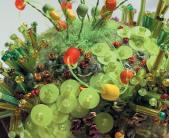
Queen, Queen Caroline Washed her hair in turpentine
Turpentine made it shine Queen, Queen Caroline.
So beautiful, but such a headstrong character: Caroline of Brunswick who, in 1795, married George, the Prince of Wales (later the Prince Regent), but to say the marriage was an unhappy one would be an understatement!
Rosy Thacker details the relationship between a Queen – more popular than her husband, King George IV – and a Hopton Hall resident.
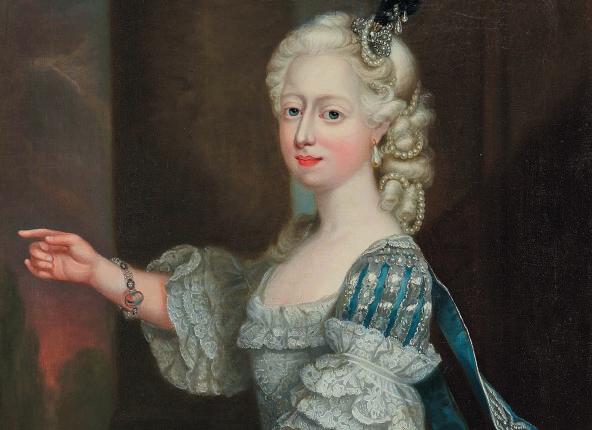
DID you ever skip or throw a ball against a wall to the rhythm of the verse above?
Some say it referred to Caroline of Ansbach, the wife of George II. She amazed the court with her progressive bathing habits. But I always believed it
referred to Caroline of Brunswick, the wife of the Prince Regent. By contrast, she was infamous for her lack of personal hygiene. During her lifetime, many ballads were written about her, in both derision and support.
When recently reading a biography of Caroline of Brunswick, I came across many references to her friend Sir William Gell, a member of the family who then lived at Hopton Hall. Also,
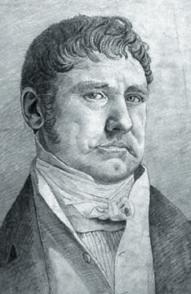
a book detailing their relationship was published in 2019 – called Queen Caroline and Sir William Gell, published by Palgrave Macmillan and written by American scholar Jason Thompson. Much of his research was done in the Derbyshire Record Office because they hold Caroline’s letters to Sir William. The letters are pasted on one edge into a book, with other correspondence.
In 1834, William Gell wrote: “I have some sixty or seventy letters of her most gracious Majesty, Queen Caroline and, Mein Gott!, what curious things they are”. He went on to say it would serve the royal family right if he published the letters in revenge for cheating him of his pension. What had happened for him to make this threat?
Caroline was the daughter of the Duke of Brunswick and Augusta, the sister of George III. In 1795 George, the Prince of Wales (later the Prince Regent), was persuaded to marry his cousin in exchange for increased funds to pay off his enormous debts.

Caroline had had a rather dysfunctional childhood, living both with her father and his mistress in the ducal palace and her mother in a separate household. She had been poorly educated. Her parents recognised that she had a headstrong, mercurial character. On the other hand, she was faithful to her friends, determined, and willing to learn from new experiences.
It is well known that Prince George took an instant violent dislike to Caroline. She managed to conceive their only child immediately; afterwards they barely crossed each other’s paths. Caroline angered the Prince further by having support from her father-in-law and any politicians opposed to George’s opinions at the time. She also had the sympathy of the general public. Everyone knew George considered himself married to his mistress, Mrs Fitzherbert, but he was blatantly unfaithful to both women. George constantly tried to find fault with Caroline and forbade her access to their daughter Charlotte. He also tried some very underhand means to fabricate evidence against her good name.
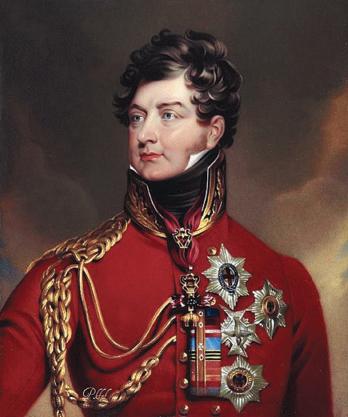
Caroline’s own social circle attracted people like Lord Byron, but also many scholars. Her frequent dinner guests included William Gell and his life-long
companion Richard Keppel Craven. William was born at Hopton Hall in 1777. He was educated in Derby and studied Classics at Cambridge. He had a very strong visual memory and was able to sketch buildings in their surrounding landscape quickly and accurately long after seeing them.

In 1807 he became a Fellow of the Royal Society and a Member of the Society of Dilettanti. The latter was an organisation of gentlemen who sponsored archaeological expeditions. Gell was grateful when they gave him funds for his travels. As a younger son, and especially after his widowed mother re-married, he received very little money from his family. He was also initially helped by Georgiana, the Duchess of Devonshire, but she died in 1806.
Gell arrived in Athens just as Lord Elgin’s agents were beginning the removal of the Parthenon sculptures now called the Elgin Marbles. Gell spent several years sketching and publishing topographical maps and drawings of Greek ruins as a guide for other scholars. He was always worried that such buildings might be destroyed.
In 1811, the Dilettanti Society gave him
a monthly salary of £50 to explore Asia Minor, now much of Turkey. He camped out at archaeological sites, often in danger from plague epidemics and pirates, and confounded by obstructive officials. He began to suffer from gout, which caused him dreadful pain for the rest of his life. On returning home, he was painted by Thomas Lawrence and knighted by the Prince Regent.
Caroline eventually decided to leave England to escape the Prince Regent’s unpleasantness. The last straw was being excluded from the celebrations when Napoleon was first defeated in 1814, even though many of her relatives were invited. The Prime Minister, Lord Liverpool, granted Caroline an annuity of £35,000 and asked all foreign governments to welcome her – he certainly did not want her back. She appointed Gell and Keppel Craven as her chamberlains. This post came with a salary, but they had to accompany her on formal occasions wearing a ridiculous livery – to the amusement of their friends. Poor Gell found himself doing a great deal of correspondence and organisation of travel documents, in addition to suffering pain when standing for long periods at official receptions.
In August 1814, the party arrived in Brunswick. Caroline’s brother was now Duke as their father had been killed in battle in 1806. But she declared it “de dullest place in de world”. They moved on through France into Switzerland. There was a bizarre encounter at a mountain inn with Napoleon’s wife, Marie Louise. The two royal ladies sang duets all evening.
Caroline spent most of her “exile” in various villas she rented in Italy. British travellers could now move freely round
Above: In 1814, Caroline eventually decided to leave England to escape her husband’s (the Prince Regent) unpleasantness. The Prime Minister, Lord Liverpool (pictured here), granted Caroline an annuity of £35,000 and asked all foreign governments to welcome her.

Europe. In Florence, for example, she met Sir Humphry and Lady Davy. Although Lord Liverpool wanted Caroline welcomed, he was dismayed at the fuss made of her by King Joachim Murat, King of Naples and Napoleon’s brother-in-law. He arranged lavish balls, opera visits and boar hunts. By the time the party reached Rome and a reception by the Pope, Gell wrote that they had “been honoured and feasted to death” and “overrun with cardinals and prelates”. Gell moreover was keen to get to Naples where Pompeii and Herculaneum were being excavated.
In February 1815, he and Craven resigned as Caroline’s chamberlains. She granted Gell a pension of £200 for life and he spent the rest of his life in Naples and Rome, living happily with several dogs in villas with pretty gardens. His many visitors included archaeologists moving through Europe to Turkey and Egypt for whom he acted as a clearing house of information.
He and Sir Walter Scott spent four months driving round Pompeii in a carriage, both too lame to walk. Edward BulwerLytton dedicated to him his famous novel The Last Days of Pompeii in recognition of his help. Gell published more of his own topographical works, such as Pompeiana; the Topography, Edifices and Ornaments of Pompeii. In 1820 his Le Mura di Roma was dedicated to Elizabeth, Duchess of Devonshire, and probably subsidised by her.
Gell and Caroline kept in touch by letter. Hers were a curious mixture of misspelt English, German and French in large and untidy handwriting. Caroline called Gell “my dear Ancharsis” (a misspelling from ‘Travels of Anacharsis’, a popular book in the 1790s) and signed often with a simple “C” or variations of “Mrs Thompson”. She wrote at length of her money problems, but also of the people she met – now a rich source for social historians.
Caroline did manage to travel further east on a ship provided from the British government. In 1816 she described her reception at the royal place in Tunis: “I am living a perfect enchantment… the dear Arrebeanins [Arabians] and
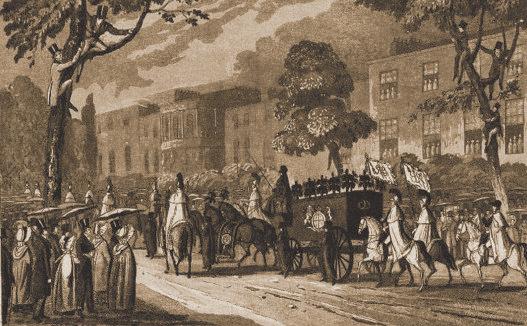
Turcs are quite darlings”. She sailed on to Istanbul and Palestine, braving storms and the perennial pirates and disease. Crowds of people watched her enter Jerusalem riding on an ass!
In one happy letter of October 29, 1817, she wrote of getting letters from her daughter Princess Charlotte and looking forward to becoming a grandmother: “I am so happy, so tranquille and so respected here (at a villa near Pesaro)…
I am then a wellestablished old lady and no more scandels can be created about poor me”.
Tragically, Charlotte and the new-born baby died on November 6. The Prince Regent did not bother to inform Caroline and then publicly criticised her lack of sympathy! She learned of her daughter’s death from a courier passing through Pesaro. A letter from her private secretary to Gell read: “Her Royal Highness’s state I leave to your imagination. My pen is unequal to the task”.
The Prince Regent was now desperate for a divorce. He imagined he could marry again and produce an heir. Caroline had played
into his hands by acquiring a handsome Italian servant called Bartolomeo Pergami who, over the years, recruited several of his family into the household. Rumours began almost at once about the relationship between the Princess and Pergami and their sleeping arrangements. A secret mission was sent from England to investigate, but it was farcically inept. When George III died in January 1820 the matter became urgent. Against much advice, Caroline returned home, determined to be crowned Queen. She initially received an enthusiastic reception from a public restless after Waterloo and critical of the new King’s morals. He could do as he liked, but if Caroline transgressed she could be tried for treason. In autumn 1820, the government introduced a Bill to deprive Caroline of her title and dissolve her marriage – a trial in all but name. A verdict had to be agreed by both Houses of Parliament. Dismissed servants were produced who were willing to testify against the Queen and confirm the gossip about Pergami. Craven and Gell (the latter in great pain and allowed to sit down at court) travelled home to resume their positions
as chamberlains and give evidence. In the end, the allegations from the dismissed servants were less than convincing. Gell’s supporting testimony went a long way to having the Bill eventually abandoned. However, for this insult to the King, Gell lost his pension when Caroline died.
The Queen’s frantic and failed attempt to take part in the coronation in July 1821 is the one thing most people know about her life. She died only a few weeks later when doctors mistreated a blockage in her bowel. Crowds of supporters flocked to the streets for her funeral procession. She was finally laid to rest in Brunswick cathedral.
Sir William Gell died in February 1836. He was buried in Craven’s mother’s tomb in the Protestant cemetery in Naples. His personal papers were left to Craven but have since been dispersed all over the world. His letters to the Queen have not been found. Her letters were bought at auction in 1949 for £22 by the Gell family and later donated to the Derbyshire Record Office.
From my readings, I think Caroline was a very complex but likeable character. It is difficult to find anything kind to say about the Prince Regent! Scholars now seem agreed that Sir William Gell was a very influential figure in early classical archaeology. I wonder if his letters to Caroline are lurking in some dark cupboard?

“Caroline had played into his hands by acquiring a handsome Italian servant called Bartolomeo Pergami.”
Martins World Travel uses only the very best Cruise Line Tour Operators, of which P&O Cruises and Fred Olsen Cruise Lines are currently the most popular.
PROVIDING many superb cruise deals and special offers at 1st4Cruises/ Martins World Travel, the well-cruised staff give customers unrivalled personal service and value. Customer care has been at the very core of Martins World Travel’s successful business for 44 years.
P&O Cruises has got the world covered. Variety is the theme with big ship facilities and unique experiences and customers can cruise with confidence knowing that so much is included in the cruise price. With excellent cruise prices and offers, guests are guaranteed exceptional value for money with amazing cuisine, optional drinks packages, superb service, and top destinations – all included! The fabulous fleet of P&O Cruise Ships includes …. Arvia, Iona, Britannia, Ventura and
Azura - big ship experiences, which are family friendly, with a wealth of facilities for everyone. Aurora and Arcadia are P&O ‘s exclusive adult-only cruise ships. Guests can choose between sailonly cruises from Southampton to longer cruise adventures and flycruise options to the Caribbean. With P&O, choices as endless!
Sail away to some amazing places on 7-, 10- and 14-night cruise options

The Norwegian Fjords are one of the planet’s most spectacular unspoilt natural wonders. It is often said that the best way to experience them is to sail them. The cruise ship will provide guests with breathtaking views of glacial valleys, magnificent waterfalls, towering mountains cliffs, and picturesque fishing villages, whilst sailing through these pristine Nordic waters.

Explore the world’s most dramatic scenery
Cruise holidays to Norway and Iceland take you to the heart of Mother Nature…to a world of vivid landscapes, punctuated by deep fjords, soaring peaks, and cascading waterfalls. The best way to unlock these treasures is through a cruise.
Norway & Iceland Cruise Holiday Highlights
For dramatic landscapes and an abundance of natural wonders, it’s hard to beat the fjords of Norway and Iceland. Some destinations simply have it all. Whether you’re a first-time cruiser or an experienced explorer, it’s hard to go wrong with an iconic Norway and Iceland cruise, that offers beauty, peace, and fun in equal measure. There are plenty of shore excursions that provide opportunity to see the fjords from a different perspective, including in Ålesund, where you can explore them from up close by kayak. For something a little warmer, hot springs are just the ticket. Reykjavik’s Blue Lagoon is perhaps the most famous example, and for good reason: the water sits at a steamy 37-40°C and is rich in silica, minerals, and algae, which are believed to have wellbeing qualities.
Travellers can take sightseeing to a new level from magnificent viewpoints on a
cruise to Norway and Iceland. While in Grundarfjörður, guests can capture Iceland’s most photographed mountain, Kirkjufell. At Rampestreken Viewpoint, there are incredible views of the mountains, Åndalsnes and the Romsdal valley below. When in Reykjavík, it’s a good idea to visit the Per-lan observation deck, which offers beautiful views over the city.
Head south to warmer climes
With their balmy climates, Spain, Portugal, and the Canary Islands generally offer wall-to-wall sunshine. Each of the Canary Islands provides lavish landscapes of promise and variety, where the people are warm hearted, and the beautiful natural backdrops beg to be explored.
Canary Island Fly-Cruises
Guests can fly straight to the very heart of these sunny and diverse islands. and enjoy a week or two in these enchanted islands, soaking up the sun and warmth along the way. On these superb cruises, it’s possible
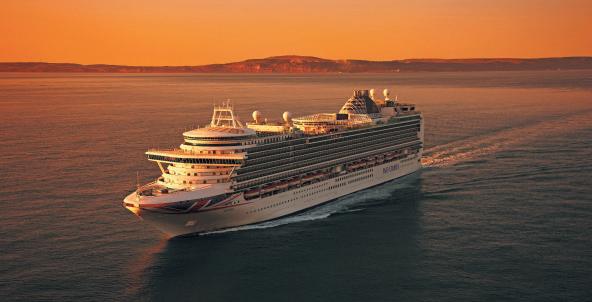
to wander the many local markets and walk along black volcanic sand or the stunning long beaches of golden sand.


Flavours to explore, quality to dine for A whole world of dining is included in the price of every holiday. From healthy to decadent, from hearty to delicate, there’s a menu and a venue for every mood.
Fresh and informal
From buffets to poolside snack bars, these casual spots are the perfect places to stop by and tuck into a tasty bite. With options available all day and even late at night, guests can enjoy delicious dishes whenever they feel peckish.
Contemporary flavours
From light bites to decadent dinners, there’s a menu for every appetite. Traditional British favourites and exotic world flavours are available throughout the day, as well as special dishes created by the ‘Food Heroes’.
Chic and special
Whether you’re celebrating a certain occasion or simply keen to indulge in an extraspecial foodie experience, these restaurants have the ‘wow’ factor.
Epicurean Dining offers that little bit extra…
The Epicurean fuses classic dining elements with the best of modern British dining to create a sensuous menu, uniquely presented in a sophisticated and contemporary setting. The emphasis is on grand style and flawless service.
Martins World Travel / 1st4cruises have the best value cruise bargains available. 7-night cruises start from as little as £499 pp. There’s also extra on-board spend on selective cruise dates. Guests can treat themselves to speciality dining experiences in themed restaurants, shore excursions, and on-board spa facilities. Now is a great time to cruise!


The Fred. Olsen Way is all about smaller size cruise holidays aboard three intimate and refurbished ships, Bollette, Borealis, and Balmoral. Fred. Olsen offers well-proportioned liners with every facility you need combined with a high level of personal service. Cabins and staterooms are comfortable and well furnished. A choice of restaurants ensures fine dining, and the level of service is faultless. Smaller ships bring you closer to ports of interest and discovering the many onboard facilities is so easy.
FEEL FREE TO CALL ON 01246 220020 or 01246 823763
Martins World Travel, 46 Knifesmithgate, Chesterfield, S40 1RQ T: 01246 220020
Martins World Travel, 25 Market Place, Bolsover, S44 6PN T: 01246 823763
martins-world-travel.co.uk www.1st4Cruises.co.uk
With choice planting and careful habitat management, it is possible to create a haven for wildlife in the smallest of spaces. Whether it’s a small garden, a courtyard or even a balcony, there are plenty of opportunities to increase biodiversity. Catherine Roth reports.
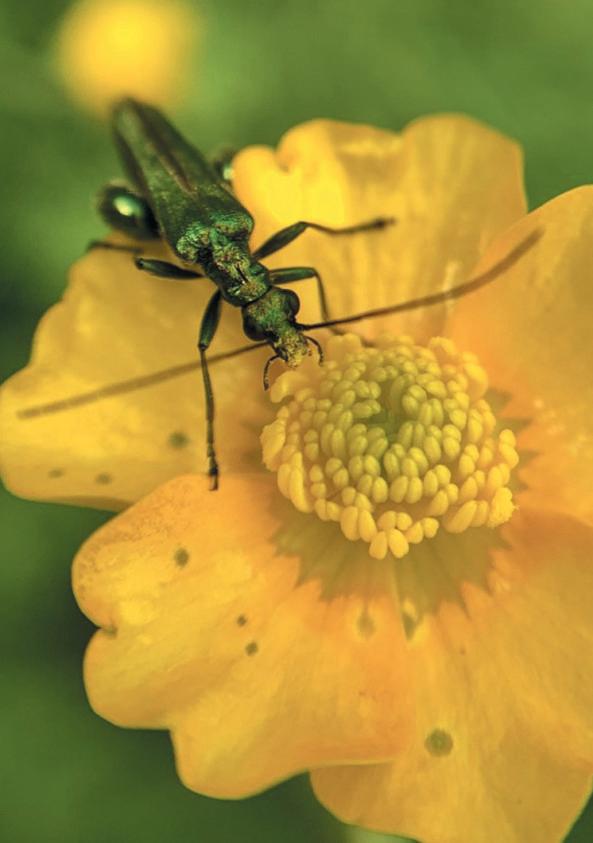
AS part of its Living Landscapes project, Derbyshire Wildlife Trust is working on restoring and enhancing habitats on a large scale across the county. However, equally important are the smaller spaces which can act as stepping stones and bridges for many different species.
Jordan Holmes, a soil scientist and Nature Recovery Advisor at Derbyshire Wildlife Trust, says: “If everyone created a stepping stone for wildlife so that their house links up to the next house, which links up to the next street, which then links up the whole village or town, we can create a vast national network.”
This could be through the planting of wildflowers, building a pond, or even making holes in fences to allow a through route for wildlife. Doing this helps to provide habitats amid infrastructure such as buildings, roads and vehicles that can severely impact populations and reduce the food sources available. Jordan says: “Butterflies are slow and low flying, some staying within 200 metres of where they were born. If they are born next to a road and another house goes up, it blocks their route.”
Variety in the planting is key to creating any wildlife garden. Jordan says: “In a really small garden – for example a six foot by six foot space – you can grow different sizes and types of plants in pots such as small low growing and mid-sized flowers as well as herbs and climbers.”
Most important, she explains, is to grow native plants as these have co-evolved
with wildlife over millennia: “Animals and plants rely on one another. Some bees come out as early as February and others stick around until November, so it’s important to elongate the flowering season. Native plants provide more variety, which is crucial to attracting wildlife, and variety means you see flowers for longer.”
Bees are important pollinators and the different species, depending on whether they are short or long tongued, will feed on different flowers. If the flowers are the wrong shapes or too deep, the bees will be unable to pollinate. Jordan says: “The common white tailed bee likes open flowers such as clover and comfrey while the red-tailed bumblebee likes open platforms to land on such as daisies. Honeysuckle and white dead-nettle attract the longtongued, buff-tailed bumblebee, which is a nectar robber as it pokes holes in the stems. Butterflies and moths are really important for garden plants too, often laying their eggs on just one kind of plant.”
Jordan adds: “In 40 years, there has been an 80 per cent decline in moths and a 30 percent decline in butterflies, so anything we can do to combat this is helpful.”
Jordan suggests growing bird’s-foot-trefoil, which attracts common blue butterflies and six-spotted burnet moths, or leaving lawns to grow with dock or sorrel, which will encourage small copper butterflies.
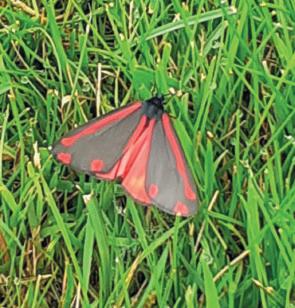
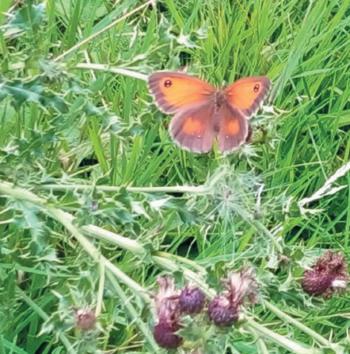
Native plants don’t tend to take over, though honeysuckle and ivy will need
to be managed by regular trimming, particularly as ivy can cause damage to brickwork. Jordan says, “Variegated yellow archangel, ground-elder and buddleia can turn into a carpet that can take over everything else. But these non-native plants can be replaced with something just as beautiful – yellow loosestrife, St John’s Wort and dead-nettle all have really beautiful flowers and are a similar shape to yellow archangel. Buddleia can be replaced by native foxgloves and rosebay willow herb, while rhododendrons can be replaced with box and yew which are evergreen, as well as guelder-rose and dog-rose.”
Turning a patch of lawn into a wildflower meadow is another way of increasing biodiversity in the garden. Although quite a bit of preparation may be needed at the outset, once the plot is established maintenance is minimal, requiring mowing only two or three times a year to ensure more flowers are able to grow and bloom. Cut in March to allow water and light through when everything starts growing, followed by another cut in August or September once the wildflowers have dropped their seed.
Another cut may also be needed in September or October ahead of the
winter germinators. After each mow, ensure the cuttings are removed – if they are left, they will break down and enrich the soil with nutrients, which are detrimental to wildflower growth.
Jordan says: “Wildflowers are not demanding – they grow well in poor soils and don’t like nutrients, so they can be out-competed by lawn grass, nettles and brambles. If you’re going to plant a meadow area, then break up the turf and sow seeds of nutrient hungry grass first to soak up the nutrients. Let this grow then cut before clearing the cuttings away to avoid the nutrients going back into the soil.” Once the soil is prepared, it’s then time to break up some bare patches and grow a wildflower seed mix, which should always include yellow-rattle. “Yellow-rattle is absolutely crucial,” explains Jordan. “It steals sugar out of the roots of vigorous grasses and slows the growth, so allows the other delicate flowers to come through.”
Even in the hottest of summers, a wildflower meadow shouldn’t require too
much water. Various plants have differing root lengths, which help to create more structure to the soil so it holds together

AS May arrives and the weather is warming up (hopefully!), gardens are filling up with early summer blooms and there are gardens open for the National Garden Scheme every weekend during May, as well as a couple of mid-week openings.
Opening for the first time for the National Garden Scheme in 2023 is Snitterton Hall, near Matlock, which will be open on Sunday, May 7 from 10.30am until 4.30pm. The four acres of gardens surround the Grade 1-listed Elizabethan manor house and include formal planting, a productive vegetable garden and a collection of sculptures. Home-made teas will be available. Dogs on leads welcome at this garden.
Brierley Farm near Ashover will be open on Tuesday, May 9 from 12noon until 4pm. The garden is set over a five-acre site and includes two acres of garden plus a three-acre woodland with paths. The high water table feeds linked ponds and areas of bog garden, and there is beautiful planting throughout. There will be plants for sale and refreshments on offer, perfect for a relaxing afternoon.
On Sunday, May 14, 27 Wash Green, Wirksworth, will be open from 11am4pm. This secluded one-acre garden boasts beautiful views, topiary, wildlife pond and productive vegetable garden and polytunnel. Plants for sale and
refreshments available; and dogs on leads are welcome at this garden.
Later in May, Moorfields in Temple Normanton will be open on Sunday, May 21 from 1-4pm. Two adjoining gardens are planted for seasonal colour, and there are island beds, a gravel garden, wildlife pond and vegetable plot. With extensive views, you’ll be sure to find a lovely spot to enjoy your tea and cake!
Also on May 21, Fir Croft in Calver will open its display garden from 2-5pm. A supporter of the National Garden Scheme for many years, this is the place to go for an extensive collection of alpine plants, sempervivums, saxifrages and primulas. The garden will also be open on Sunday, June 4 and Sunday, June 18. Details of all gardens open during May can be found at ngs.org.uk

better – unlike lawn grass, which has very shallow, fibrous roots leading to bare patches in dry, dusty soil.
The availability of water is a necessity and ponds can be added to a garden at any time of year. Jordan says: “It is particularly important in the drier months and in urban environments when wildlife can struggle to find sources of water.” The ideal spot to site the pond is in two thirds shade as insects and other pond dwellers are better able to cope with cooler temperatures than hot – but it still gets sufficient sunshine allowing the water to warm up in the spring.
Once a pond has been installed, a couple of weeks should be left between filling it up with rainwater and introducing plants, so allowing the pond liner time to stabilise. When adding plants, Jordan advises against removing them from other ponds, as this can spread disease and pathogens, but to buy new ones from garden centres. Some native pond plants she recommends include small water-milfoil, water mint, water starwort, lesser spearwort and flowering rush. “Water attracts a lot of insects and these then encourage the birds and bats.
A lovely community can develop around a pond and its planting.”
There is no minimum size for a pond and, if space is at a premium, a mini pond can be created using just a small bowl containing pebbles from which wildlife can drink. Alternatives include a buried ice cream tub or a washing up bowl with a ramp so animals can easily get in and out of the water.
Other homes for wildlife can also be added to gardens such as bird, bat and bug houses – just make sure any wood hasn’t been treated with a chemical preservative.




Before the winter sets in, it can be tempting to tidy up the garden and cut back vegetation. However, while it may look a little untidy, it will provide somewhere for wildlife to overwinter and survive. For example, the eggs and larvae of insects will find shelter in the long hollow stems of willow herb and foxgloves, while dead wood supports many native insects and beetles. For animals and insects that are not hibernating, ivy provides a very important food source in the winter months when there are no berries or flowers.
While much can be brought into the garden to attract wildlife, it is also important to avoid those things that are detrimental – such as eliminating the use of herbicides and pesticides, using peat free compost, replacing fences with hedges, and not covering the ground with tarmac and brick. Jordan says: “If water and air can get in, this encourages healthier soil and worms and beetles can be active. Drainage is also better around the house and garden.”
Even seemingly natural landscapes can benefit from greater biodiversity. Jordan says: “Across Derbyshire, the national park tends to be quite sparse with local wildlife. It’s rich in plants but it’s not a natural landscape, which is a surprise to many people. The moorlands have very much been shaped
by mining and farming. At Derbyshire Wildlife Trust, we’re encouraging tree planting and meadows to bring back the biodiversity and to link up places.”
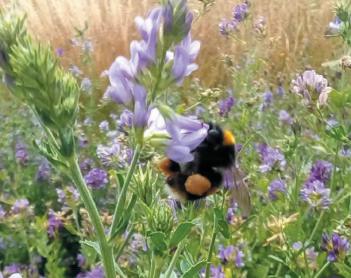
It is this linking up of places by forming stepping stones and bridges for birds, insects and animals that is key to increasing habitats for wildlife and creating more green spaces. It doesn’t have to be difficult either – this is the month of “No Mow May”
after all, so why not sit back, let the grass grow that little bit longer and look forward to welcoming new visitors to your garden.

Editor’s Note: For more details about creating your own wildlife garden, visit www.derbyshirewildlifetrust.org.uk
 Above: A bombus terrestris female, with pollen pockets, on sainfoin. Picture by Jordan Holmes.
Above: A bombus terrestris female, with pollen pockets, on sainfoin. Picture by Jordan Holmes.

WHAT would a spring issue be like without a picture of a newborn lamb? Well, we can thank Shelley Ward, of Smedley Street, Matlock, for getting this picture of a newborn lamb near Hartington on
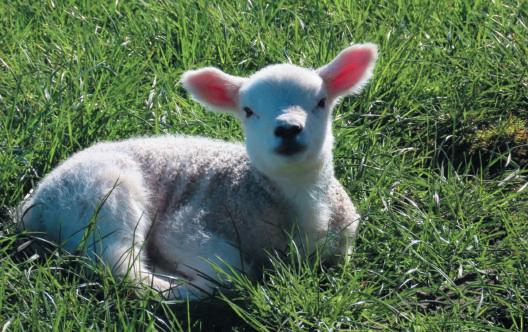
April 10 – just one of a great selection of entries into our 2023 ‘Derbyshire’s Wonderful Flora & Fauna’ competition. What is much rarer is to spot a wheatear – but Russ Teale, of Newbold, managed it near Ashford in the Water
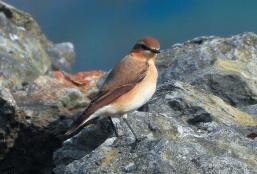
on April 18. What’s more, it looks like it posed for him!
Next, a picture by Ian Moorcroft, of Hollingwood, who says: “It’s Bakewell – and spring has arrived”. Indeed, Ian! Here’s a pair of Mandarin ducks at Linacre

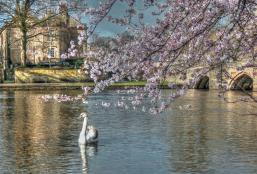
Reservoir, taken by Simon Hampton, of Walton.
“The eyes are amazing on this frog at Longcliffe,” says Mark Ward, of Brassington.
Plenty of frog spawn, too, in the pond on this picture, taken on April 2.
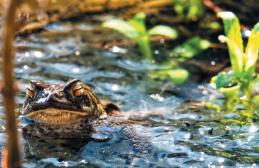
“A pair of loving ravens,” is how Russ Teale, of Newbold, describes his image taken at a quarry at Hartington last month.
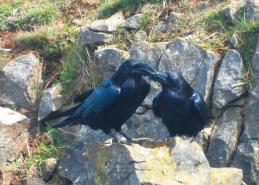
Next, a picture of “one of the many robins that keep you company when you walk along Chesterfield Canal,” says Ian Moorcroft, of Hollingwood.
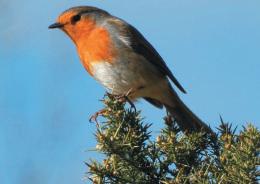
An interesting view towards Hathersage, next, taken from Robin Hood’s Cave on Stanage Edge by Emma Bakewell, of Dronfield, on March 26.

Lovely colour spotted on a walk around her village by Christine Waddington, of Great Longstone, who says: “Spring is definitely here with a year of hope in front of us.” Amen to that, Christine!

A grass snake wriggles through the undergrowth on the Eastern Moors, taken on April 4 by Peter Wigglesworth, of Matlock.
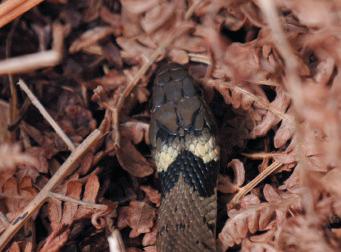
So elegant – a swan on the river Wye near Bakewell, captured by Pauline Chapman, of Bakewell on April 15.

“I took the photo of a fallow deer jumping a fence as I was walking through Chatsworth on a lovely April day,” says Simon Hampton, of Walton.

And here we have what is one of the Baslow Edge ‘regulars’ now, a Highland cow, pictured by Andy Hanna, of Great Longstone.

Next, “cowslips spotted on my morning walk at Hardwick Ponds, brightening up a rather dull and rainy Friday in April,” says Janice Dyson, of Wingerworth, of this picture.
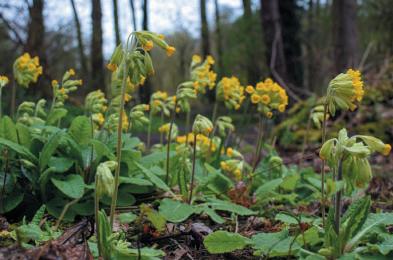
Such a lovely bird, the curlew, and Russ Teale, of Newbold, spotted one near Clodhall Lane in late March.

In this year’s competition, you can take stunning images of plant life or wildlife or
both – it’s up to you. The picture(s) you send must be taken in 2023 and must be in Derbyshire and you can enter as many times as you like. We want entries from amateur snappers and not commercial photographers; and drone images will not be accepted.
Please email your entries to barrief@bannisterpublications. co.uk, giving your full name and address, a contact telephone number and a description (including the date it was taken) of the image, which should be attached as a high-res jpeg. The winner will receive a meal for two at a top local restaurant, plus the chance to have a selection of their images published in Reflections The deadline for entries is Monday, October 16, 2023.

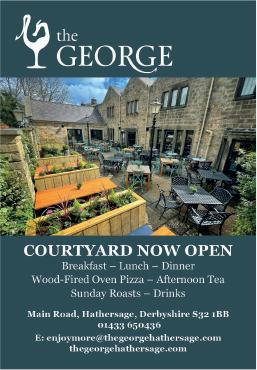


ON Spring Bank Holiday Monday, May 29, the banners will be flying and the bands playing again as people from a wide range of churches and charities unite in an event that has been running since 1850.
It begins in front of the Town Hall with an open-air service on Rose Hill, scheduled to begin at 9.45am. The Walk itself commences at around 10.15am, led by the Mayoral party.

This year, the route has been changed to bring the event to a wider audience, through the Market Place and along Vicar Lane, returning to the Town Hall via Burlington Street and High Street for the closing ceremony. Rose Hill URC church will be open for refreshments.
Some readers will know the procession as the “Whit Walk”. In the church calendar, Whitsuntide is the festival that celebrates the first coming of the Holy Spirit in power upon the disciples of Jesus at the Jewish feast of Pentecost. Their subsequent witness
for Christ spread throughout the known world. The Procession is a symbolic “going out into the world” by the local churches in memory of the event that was, in essence, the birth of the Christian Church.
Archive photos from the turn of the last century illustrate how the Walk has changed and adapted as the years have gone by. It began as a Sunday School demonstration in times when practically every child attended classes in church each Sunday. Indeed, in the days before state education became established, these were often the only classes they ever attended.
A national body, the Sunday School Union, was established to which bona fide schools were affiliated. White, as a symbol of purity, was the traditional dress colour for the Sunday services at festival time and was worn again for the Monday parade.
“White Sunday” was the origin of the name Whitsuntide. Hence the dresses in the early pictures. In the days before competition was
frowned upon by educationalists, churches vied with each other to produce the best decorated float, depicting some topic, biblical or current, and awards were given.
For more than a hundred years, bible classes on Sundays were well attended and the Sunday School Union organised an annual Bible Exploration culminating in written exams with prizes for the highest marks at local and national level. Average performance by each Sunday School was also assessed and a shield awarded at the Whit Walk to the best in town. I still remember Whitsuntide 1966, the one year that my own Ragged School, against the odds, lifted the trophy. There was some kind of football competition that year too, but for members of our exam team, that was of lesser significance!
As may be seen in the photos, the location of the open-air service and the route walked have both changed over the years. The Market Place, in the days when market stalls were
avid Botham (2023 President of Christian Education, Chesterfield) explains.
easily demountable and labour cheap, was once the principal place of assembly for big public events. Only in recent times has Rose Hill taken on that role. The Town Hall steps and landing make a good platform but those who have braved it in strong winds and driving rain do find it unfriendly to umbrellas. Churches pray for a fine morning but most are intrepid enough to turn up whatever comes their way. Old photos show the march on St Mary’s Gate, Clarence Road, and Newbold Road where willing patients in Scarsdale or the old Royal Hospitals would be helped outside to see the Walk go past. On the north side of town, increased traffic and much reduced shops and bystanders have persuaded the organisers to bring the route back through the Market Place. For some, that will re-kindle a few memories.
Whitsuntide walks by churches were once common in towns and cities. Chesterfield’s is a remarkable survival. It began before so many things that we take for granted; electricity, photography, the motor car or any sort of phone even existed. It continues despite world wars and global pandemics.
Each year, the procession highlights aspects of the Christian faith. This time, since the Coronation will have happened just a few weeks earlier, then “King of Kings” will be the theme. While some may have doubts about the British monarchy, there
Top right: Churches and Sunday Schools vied with each other to produce the best decorated float, and here is a maypole.
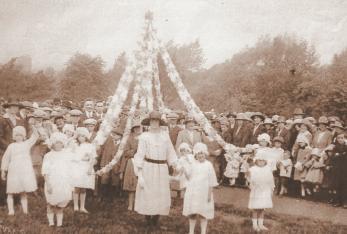
Right: White, as a symbol of purity, was the traditional dress colour for the Sunday services at festival time and was worn again for the Monday parade.

Below: At Chesterfield’s last Whit Walk in 2019, here is the Ragged School float.
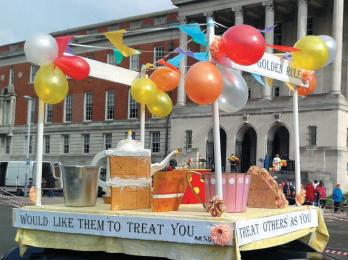
is no doubt about Christ’s place as King of Kings for all time. As the hymn writer put it: “Crowns and thrones may perish, kingdoms rise and wane, but the Church of Jesus constant will remain” (from Onward Christian Soldiers by Rev. Sabine Baring Gould).
Educational theory and practice have changed. What used to be the local branch of the Sunday School Union is today known as Christian Education Chesterfield. Member churches continue to organise the town’s Whit Walk and welcome everyone to this year’s event.
The Walk is held on Spring Bank Holiday Monday because it is the nearest British public holiday to Whitsuntide. This year it falls on May 29, which coincidentally is the weekend of both the Whitsuntide festival and the 200th anniversary of the church on Rose Hill. After two years of Covid-19 and a further year with no Spring Bank Holiday Monday at all, it will be good to see a colourful procession of renewed hope and faith back on Chesterfield’s streets again.
Steve Brown ventures into Staffordshire (but still in the Peak District) this month to enjoy a lovely walk taking in Luds Church and The Roaches.

MOST walkers access The Roaches ridge and Hen Cloud from the minor roads surrounding the main ridge from Upper Hulme. This route, however, starts from the north and takes in the mysterious chasm of Luds Church, some beautiful woodland and gives an excellent extended walk along the bulk of the main ridge itself.
Much of the moorland is cloaked in heather, which makes for a glorious purple landscape in late summer. On a clear day, the views from the main ridge are expansive to the south and west over the Midlands plain, stretching as far as the Shropshire Hills on the horizon.
From Gradbach car park, by the rushing waters of the infant River Dane, head west up the tarmac lane and descend to Gradbach Mill, now a conference centre. As you enter the yard in front of the mill, turn left up the steps to a gate by Gradbach Farmhouse and follow the obvious path down the valley to a gap in the wall by a green Peak and Northern footpath (PNFS) sign, number 574.
Turn right down to a footbridge, cross it and head up the slope opposite, with
stone steps at the top, turning right onto a gently rising path through Forest Wood until the prominent Castle Cliff rocks are reached on your right. Turn sharp left here at a signpost and follow the contouring path until the entrance to Luds Church is reached on the right just by a rustic rail fence.
Descend into the gloomy depths of the chasm with moss and fern-laden rock walls looming above. This remarkable rift was caused by a freak splitting of the

START: Gradbach Car Park, SK17 0SU. GR SJ9990166206. Accessed by minor road from Flash village off the A53 Buxton to Leek road; follow brown signs to Gradbach Mill.
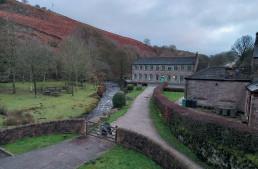
LENGTH: 9.9 miles (16km)
ASCENT/DESCENT: 400 metres of ascent/descent.
TIME: Allow up to 6 hours with stops
hillside; its name is attributed to Walter de Ludank, a follower of John Wycliffe, who is said to have held secret services here in the 14th Century.
Head through the cleft and climb out via the right branch on some stone steps. Continue through the woodland on a series of boardwalks erected by Staffordshire Wildlife Trust and on to a signpost at a footpath junction. Turn left but then almost immediately right by another signpost and continue through lovely woodland on a path, negotiating many tree roots underfoot, until the path descends to a junction of paths by yet another signpost. Turn right, crossing a small stream and ascend the valley side with the eroded path, reaching and following a wall on the left until you reach the ridge and a junction of roads and paths at Roach End.
Take the quiet minor road to the left which ascends gently then contours the northern flanks of The Roaches ridge,

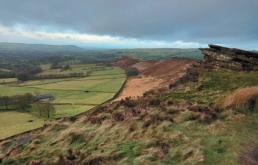
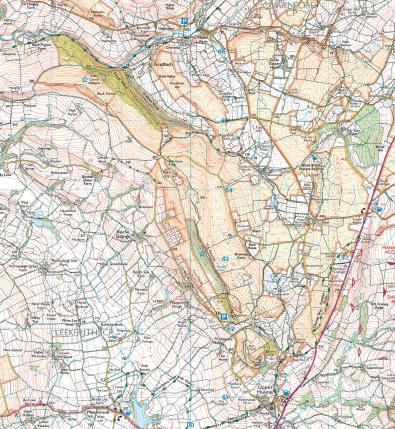
with excellent views over the moorland to the north, Shutlingsloe being especially prominent. Keep along the road with its grass verge, passing first Shawside then Shaw House on your left. The road bends slightly left then left again after the latter. Just beyond the second bend take a gravel farm track on the right, over a cattle grid, and follow this through a gate, keeping right at a fork, until it reaches two side by side gates further on before Summerhill Farm.
Take the right hand gate onto a wet track which rises gently to a col, where there is a sudden view of Hen Cloud and Tittesworth Reservoir in the
valley below. The obvious track descends to a saddle between the main Roaches outcrop to the right and Hen Cloud to the left. Go through the wall on the left by a gate by another green PNFS sign and cross a narrow green field to another wicket gate. Hen Cloud looms ahead and it is an easy ascent to its rocky summit by the obvious path
up its slopes. The name means “high rock” and it seems entirely appropriate on this fine summit with expansive views all around. After taking in the prospect descend the way you came to the gate by the PNFS sign but then ascend the slope in front on a prominent path to reach the foot of the mighty face of the Roaches upper tier and a sea of
OUT & ABOUT
boulders below it. If the weather is clement, rock climbers will be seen in action on the face above, perhaps tackling the notorious overhang of ‘The Sloth’.
Pass below the main face into the straggly woodland and when the high rocks peter out, take a rocky path up to the ridge via a prominent notch. You are now on the main ridge of The Roaches and the only instruction you need is to follow the path past Doxey Pool, many
rocky outcrops and the white trig point on the summit of the hill at 505 metres; before the now paved path descends to the road at Roach End.
The magnificent views back along the ridge towards Hen Cloud show off to best effect the great breaking wave of rock which is the glory of The Roaches; the name Roaches is almost pure French, derived from the word “Roche” and seems entirely appropriate in this location.
At Roach End, cross the road and keep on along the ridge in front on a good path. Keep right at a junction by a signpost, continue over a minor summit and go over a wall by a gate after another footpath crossroads, ignoring the signposted descent to Gradbach on the right.
Eventually the ridge path descends to meet a prominent track crossing the ridge at a gateway; turn
Ten years of protecting its unique wildlife…
of Special Scientific Interest (SSSI) and forming part of the South Pennine Moor Special Area for Conservation (SAC) and Special Protection Area, The Roaches consists of numerous internationally important habitats including blanket bog and upland moorland. There are also many specialist breeding and wintering birds such as curlew, red grouse and tree pipit. SWT’s two volunteer groups and rangers continue to carry out essential conservation work and improve visitor

INGREDIENTS
1 onion, finely sliced
3 garlic cloves, finely chopped
2 bunches (250g) wild or farmed
asparagus, chopped into small chunks
4 free-range eggs
METHOD
sharp right here on a track which contours above the Dane Valley to the left then descends into woodland to meet your outward route at Castle Cliff rocks. From this point simply retrace your steps via Forest Wood and Gradbach Mill to the car park.
SERVES
access. SWT spends around £100,000 a year caring for this special place, so if you love The Roaches, you can join them. You’ll get a dedicated Wild Staffordshire magazine three times a year plus info on loads of events, walks, talks and volunteering. Call 01889 880100 or visit www.staffs-wildlife.org.uk

THE Red Lion at the Peak Edge Hotel at Stonedge is the 2023 National Pub & Bar Awards county winner for Derbyshire.
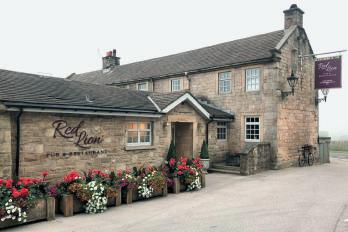
The Red Lion is among 94 venues selected as the best in their respective counties, in a competition organised by Pub & Bar Magazine, and they all go through to the grand final awards ceremony, which takes place in London on June 28.
There, the county winners will discover which pubs will be taking home a regional title, as well as which place earns the overall National Pub & Bar of the Year accolade.
“We were overwhelmed by the level and quality of entries this year,” says Tristan O’Hana, editor of Pub & Bar magazine, which runs the awards. “It just goes to show what magnificent work is going on across the UK hospitality sector. With outrageous energy costs, recruitment shortages and a punishing taxation system, these businesses are once again facing tough times. Now, more than ever, it’s vital that people support their local pubs and bars.”
Part of the Casa Hotels Group, the 4-star Peak Edge Hotel has also won the 2023 Hitched Wedding Award and got silver in the 2023 Peak District & Derbyshire Hotel of the Year award; with the Red Lion Restaurant getting gold in the 2023 Taste of the Peak District & Derbyshire Award.
The Red Lion is the Peak Edge’s 2 AA Rosetteawarded restaurant, using local and seasonal produce, much of it from
the Walton Lodge Farm Estate owned by Steve Perez, chairman of Global Brands and Casa Hotels Group.
The Red Lion restaurant is also a finalist in The Publican Award’s Best Premium Food category. Steve Perez said: “I am especially proud to be nominated for Best Premium Food offer at the Red Lion Restaurant, which was owned and successfully run by my father in the Seventies, and I bought it back into the family five years ago.
“Our ethos is to produce the highest quality sustainable food most of which is sourced from my farm just two miles away. Executive Chef
Ben Peverall works closely with Craig Ellis, my farm manager, to produce the ultimate field-to-fork food, everything from beef, lamb and pork to honey from our own bees.
“Our Berkshire pigs live in the woods, where they are fed on the brewers’ grains from our Chatsworth Gold beer, a local brew sold on tap in our establishments. We have an abundance of game on the menu when in season. Alongside this we are currently installing a biomass facility which will allow us to heat the water for our laundry across both sites. It is wonderful to continue my father’s legacy, watching it grow and prosper.”
The National Pub & Bar Awards 2023 is sponsored by Heineken, ICRTouch, Kerrymaid, Lamb Weston, Loomis, Majestic Commercial, Mission Foods and Schweppes.

THE 12th annual Food Festival will take place in Tideswell on Saturday, May 13. The event, open from 10am-4pm, has live music and street entertainment throughout the day. Entry is free.
The event promises a spectacular array of food stalls as well as arts and crafts in the Makers Market inside the historic church. Mouth-watering food will be on offer from a wide array of vendors, including Wye Bakehouse, Project D Donuts, Staffordshire Savoury Scotch
eggs, Bespoke Brownies and many more. Visitors can enjoy lunch from hot food vendors such as Alvi’s Home Made Indian, Caribbean Fusion and I Love Crepes.
On behalf of the organising team, Julia Fell said: “It’s a fabulous day out in our picturesque village, with people travelling from near and far to sample the local food, buy gifts and treats, and soak up the vibrancy and charm of the village.”
Tideswell food festival began in 2011 and its popularity has seen the festival
grow year-on-year. Now it includes an artisan Makers’ Market in the stunning ‘Cathedral of the Peak’, with work from local artists and craftspeople on sale.
Local traders throw open their doors, including pubs and cafés, an organic butcher, a bakery, wool shop and dyeing studio, and a second-hand bookshop.
Tideswell Food Festival is a community event with surplus funds supporting local projects. For more information visit https://tideswellfoodfestival.co.uk
“Our ethos is to produce the highest quality sustainable food most of which is sourced from my farm just two miles away."
 By Vivienne Milburn
By Vivienne Milburn
AKUTCHINSKY ribbon brooch designed as a flower head was discovered in a bag of mixed jewellery at a house in Hope Valley and it made £1,260 in a recent specialist auction. Yes, in the language of modern culture, Kutchinsky’s jewellery is really “sick.”
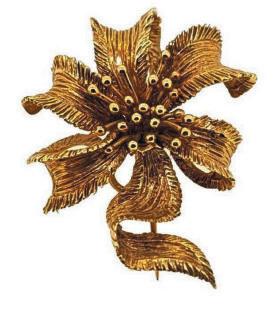
It is highly likely that many people are dismissive of the quirky looking appearance of Kutchinsky jewellery. However, they are at the top of the retro collectors list and sell for premium prices at auction. There
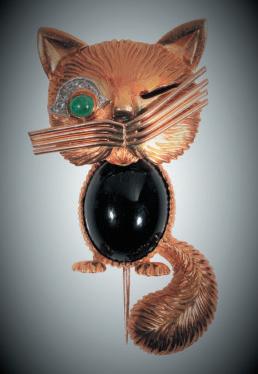
is also the bonus of the family having an interesting back story.
The Kutchinsky business was established in 1893 when Hirsch Kutchinsky arrived in England, having fled Poland along with his son, Morris, and other members of the family. They brought with them many years of experience in the trade, having served as jewellers to the court of Ludwig of Bavaria.
In the 19th century, Russia was a vast country – it reached from the Baltic to the Pacific –and covered substantial portions of both Europe and Asia. The
population of the Russian empire was extremely diverse, and issues of national identity were rarely clear. Borders were uncertain and many of the subjugated nations clung to their own group identities, refusing to call themselves Russians.
By the end of the 19th century, this vast country was on the verge of an era of tumultuous change and suffered from overpopulation, widespread
famines and political unrest. Many of the empire’s peoples joined the great worldwide migration of the last decades of the century. Within a few decades, the Empire would be overthrown in a socialist revolution and torn apart by years of war. Three of the groups to join the exodus were the Russians, the Poles, and the Jewish people of Eastern Europe.
Many examples of Kutchinsky
jewellery were made during a time of extreme austerity. The pieces are often refreshingly bold and harnessed the growing sense of optimism of the beginning of the post-war period. Much of the jewellery they made during the late 1940s and 1950s was purposefully ostentatious. Whimsical designs of animals and birds have become synonymous with the name Kutchinsky and the firm created a menagerie of characterful creatures over the years.
Being such an enormous success in the jewellery, art and fashion worlds, you would think that the Kutchinsky family came from a background of financial privilege. In fact, Kutchinsky Jewellery started off as a new business in London’s East End shortly after the family fled Poland. The first shop was on Commercial Road, where they became well known for their fine platinum and diamond jewellery. By 1928, Joseph Kutchinsky, then only 14, the youngest grandson of the “first” Kutchinsky, began his long and successful career in the family business.
Known simply as ‘Jo’, Joseph was a natural salesperson and worked to instil the core values of the business – quality products and excellent service – into everything the brand produced. By 1958, the shop on Commercial Road had become a mecca for lovers of fine jewellery and, with this success, they made a move to London’s Knightsbridge. Kutchinsky jewellery had gained a reputation for being extravagant, theatrical and exuberant – a celebration of the end of the war and the growing availability of luxury goods.
Stylistically, Kutchinsky jewellery stands out against a backdrop of mass-produced items. Its uniqueness is a leading

factor in the brand’s iconic status and has also contributed significantly to the demand for, and value of, the jewellery. The brand is intrinsically linked with experimentation. It’s the stylistic freedom that makes Kutchinsky pieces so sought after by collectors.
The value of the jewellery often doesn’t lie exclusively in the value of the materials used, but that they so beautifully encompass the spirit of ‘rebuilding and starting again’. The jewellery created by this distinctive brand is physical evidence of an optimism that so starkly contrasted with the preceding years of destruction, uncertainty and deprivation.
Because of its symbolic link with a specific period in British history, Kutchinsky jewellery is highly sought after in the antique world and its rarity makes it inherently valuable in specialist auctions.
Editor’s Note: If you have antique jewellery and collectable items, it is always worth getting the advice of an Independent Antiques Valuer to assess your items. For further information, please contact Vivienne on 01629 640210 or 07870 238788. Alternatively, go to www.viviennemilburn. co.uk or email vivienne@ viviennemilburn.co.uk

“Kutchinsky jewellery had gained a reputation for being extravagant, theatrical and exuberant.”
5



May 19 Tim Vine: Breeeep!

May 31 Ben Fogle: Wild

May 13 Come & Sing: Kate Rusby
12
19
BOX OFFICE: 01298 72190 www.buxtonoperahouse.org.uk
MAY
31
JUNE
1 Buxton Opera House 120: Starring Russell Watson
2 RNCM Songsters (Pavilion Arts Centre)
2 Buxton Buzz Comedy Club (Pavilion Arts Centre)
3 Buxton Live Acts Revue (Pavilion Arts Centre)
3 Anything for Love: The Meat Loaf Story
8 Henry Normal: Collected Poems and Other Landfill (Pavilion Arts Centre)
8 Jimmy Carr: Terribly Funny 2.0
BOX OFFICE: 0114 249 6000 www.sheffieldtheatres.co.uk


MAY
3-7 LLP Solicitors World Seniors Snooker Championship (Crucible)
9-20 The Ocean At The End Of The Lane (Lyceum)
10-11 Dead Cats (Playhouse)
12 Festival Launch: Songs & Dances
13 Family Concert: Izzy Gizmo (Crucible)
13 Come & Sing: Kate Rusby (Crucible)

13 Climate Change: What Can Music Do? (Adelphi Room)
13 Notes On A Protest (Crucible)
13 Moonlight Sontata (Playhouse)
14 Sunset: Death & The Maiden
(St Martin’s Church)
15 Bach, Beethoven & Brahms
(Playhouse)

16 The Art of New Tango (Playhouse)
17 Hungarian Dances (Playhouse)
17 The Music of Strangers (Showroom Cinema)
18 Breathtaking Sax
19 La Mer: Two Pianos and Sax (Playhouse)
20 Finale (Playhouse)
23 A Night At The Musicals (Crucible)
24-27 The Spongebob Musical (Lyceum)
25-27 Quality Street (Crucible)
25-26 If All Else Fails (Playhouse)
27 Bossy (Playhouse)
30 – June 3 The Mousetrap
JUNE
1 Buffy Revamped (Crucible)
3 The Fossil Kids (Playhouse)
9-10 Showstopper! The Improvised Musical (Lyceum)
BOX OFFICE: 0114 2 789 789

www.sheffieldcityhall.co.uk
MAY
5 The Music of Lord of the Rings, Game of Thrones and Beyond
6 Last Laugh Comedy Club
6 Scott Bradlee’s Postmodern Jukebox
10-13 Manor Operatic Society presents Grease
13 Last Laugh Comedy Club
14 What’s Love Got To Do With It?
17 Estonian National Symphony Orchestra
18 Steve Harley Acoustic Band
19&20 Last Laugh Comedy Club
21 A Night of Champions: Best of British
25 When You’re Smiling: Neil Sands
26&27 Last Laugh Comedy Club
26 Forbidden Nights
31 Carrie Hope Fletcher: An Open Book
JUNE
2 Killer Queen: A Tribute to Queen
3 Royal Liverpool Philharmonic Orchestra
4 Shalamar: 40th Anniversary Tour
BOX OFFICE: 01142565656
www.sheffieldarena.co.uk
MAY
11 2023 Cazoo Premier League Darts
13 Andre Rieu
TOYAH performs a unique one-off show in the dramatic setting of The Devil’s Arse Cave at Castleton in July.
Following her 2021 charting album ‘Posh Pop’ and over 80 million worldwide YouTube views for her weekly Sunday Lunch videos with Robert Fripp; music legend Toyah is back on tour.

Toyah Willcox’s career spans 43 years, 30 albums, over 25 feature films, countless TV and theatre roles and two books.
Performing her smash-hit singles, I Want To Be Free and It’s A Mystery, and many more classics in Peak Cavern on Saturday, July 22. Doors open at 7pm. Tickets cost £27.50 in advance. To book, go to https://www. thegigcartel.com/Artists-profiles/Toyah.htm

THIS year’s Chesterfield Philharmonic Choir summer concert will be a selection of well known (and not so well known) opera choruses. The programme will include such favourites as the Easter Hymn from Cavalleria Rusticana, Verdi’s Chorus of Hebrew Slaves from Nabucco and the eerie Witches’ Chorus from Verdi’s Macbeth.
The choir is delighted to welcome Jonathan Scott, the renowned organist and one of the choir’s Vice Presidents, to share the platform.
JUNE
5,7,8 & 9 Gladiators
MAY
8 King’s Coronation Party at Matlock Farm Park. Wear your red, white and blue outfits for the party on Bank Holiday Monday! Super children’s entertainer Barney Baloney, a Coronation comedy and magic show, and an afternoon horse parade. There’ll also be Coronation crafts for little ones to get involved in, and animal fun including sheep racing, small animal handling and more! For more information visit: www.matlockfarmpark.co.uk
12-14 Chatsworth International Horse Trials. Enjoy world-class competition, from elegant dressage and exciting show jumping to gripping cross country. The event offers a range of entertainment and activities for the whole family, including a family fun dog show. Browse our shopping village with over 100 high-quality trade stands including a choice of catering outlets. Dogs on leads are welcome at the horse trials. Please do not leave dogs in cars. The house, garden, farmyard, and playground are open as usual during the horse trials. Tickets are available online and at the gate (card payments only). All tickets
Jonathan attended the prestigious Chethams School of Music before gaining a scholarship to the Royal Northern College of Music. He now has a busy international concert schedule and we are fortunate to welcome him to Chesterfield.
The concert will be held on 24 June, 7.30pm at Church of St Mary & All Saints (The Crooked Spire). Tickets: £14 (adults), £12 (seniors), £5 (students and unemployed) and free for children under 16; available by emailing ticketoffice@ chestphilchoir.org.uk, from our website, Chesterfield Visitor Information Centre and choir members.
include free parking and child prices apply for those aged 5–15 inclusive. Children under the age of five are free. To book www.chatsworth.org
13 The Gin & Rum Festival in Derby. Discover new favourites with samples from our hand-picked guest distillers, treat yourself at our themed gin and rum bars, and let your hair down with friends whilst enjoying music from our award-winning DJ and live entertainment. Not convinced that gin and rum are for you… then head over to the cocktail bar. Over 18s only admitted. For more information, visit www.ginandrumfestival.com
13-21 Chesterfield Area Walking Festival. Enjoy the Chesterfield area on foot, discovering Big Moor with its stone circles, searching out wildflowers in ancient woodlands, or going on a treasure hunt around Spital Cemetery. Explore history in the landscape on the George Stephenson ‘Rocket Man’ walk or a ‘Tale of Two Pits’. You can even help clean up Chesterfield or go on a Bumblebee Safari. Find out what walks are on offer, or to book, go to www.visitchesterfield. info/whats-on/walking-festival
13 Wyns Tor Singers Summer Concert, with flautist Katy Strudwick. At All Saints’ Church, Youlgrave, at 7.30pm. An evening of fine choral music, folk
songs and contemporary works. Flautist Katy is accompanied by Andrew Marples. Tickets £10 from Youlgrave Village Shop, Youlgrave Post Office, or on the door.
13 Dethick, Lea & Holloway Horticultural Society Spring Plant Sale at the Florence Nightingale Memorial Hall, Yew Tree Hill, Holloway, DE4 5BD, 10am-12noon. There will be a good selection of plants for sale: bedding, hardy perennials, tender perennials, salad, herb and vegetable plants, and plants suitable for wildlife. There will also be cakes and preserves for sale. Entry is free.
18-24 Tissington Well Dressing. This ancient custom is all but unique to Derbyshire, and Tissington is the first of this season, with six wells dressed. For further information, contact the events team on 01335 352200.
20 Chesterfield and District Family History Society Annual Fair. The themes are ‘Who Do You Think You Are’ and ‘Old and Curious Occupations’. Displays, free talks and a genealogy helpdesk. At St Thomas’ Centre, Brampton, 10am-4pm. Admission £3.
27 Wessington Orchard Artisans Market 2023. Set in a lovely location, the market is dedicated to local producers and artisans in a beautiful orchard overlooking the Amber Valley. Free entry and free parking! On-site parking is limited and can be booked. Parking is also available in the village (please park considerately) and the market is just a five-minute walk away. Free parking can be booked via ambervalleyvineyards.co.uk
JUNE
2-10 Chesterfield Cycling Festival 2023. A programme of cycle rides will be led by members of Cycle Chesterfield and there will also be a number of other bike-related events. The rides will vary in length, ranging from the gentle Art Trail Tour to visit interesting local sculptures to a full day out on a 40-mile loop mainly on trails and quiet roads. To show that cycling can be
CHESTERFIELD Gilbert & Sullivan Society are looking forward to singing at two churches in May. The concert at Bolsover Parish Church on Wednesday, May 24 (7.30pm) will be the first time the choir have appeared in the town. Friday, May 26 will see the choir singing again at Holy Trinity Church (7.30pm) on Newbold Road, Chesterfield.
DISCOVER how walking can benefit your health and well-being on guided walks with the Peak Park rangers.
Ranger Mike Pupius said: “Our mindfulness guided walks introduce you to ways to enhance your enjoyment of the Peak District’s natural beauty and, in turn, gain the health and well-being benefits of connecting more deeply with nature.”

Among the walks are:
Tuesday, 16 May: Mindfulness and Nature Connection Walk (7 miles)
Mindfulness trainer and National Park ranger Mike Pupius, and sound expert Charlotte Swain, offer the chance to truly appreciate the tranquillity of the upper reaches of the Dove Valley. The walk will start in Hartington village. £10 per person aged 18 and above. Children aged 17 and below go free with paying adults.
Friday, 19 May: Minninglow and Roystone Grange History and Flowers (4 miles)
A walk starting near Pikehall along the flower-lined High Peak Trail to ancient Minninglow, where you will visit the Neolithic chambered tomb and Bronze Age barrows. £10 per person aged 18 and above.
Saturday 20 May: Win Hill – Summit, Woods and Water! (7 miles)
Starting from Heatherdene car park, you will visit old wells, hear the story of Bamford Mill and tales of myth and legend. A steep climb of Win Hill
for everyone, there will be a session of Adapted Cycling (cycling for those with a disability and their carers) in Queen’s Park and some Dr Bike repair workshops, both run by Inclusive Pedals. All events will be free but some may require pre-booking. Further details at www.chesterfieldcc.org.uk
3 North Derbyshire Cottage Garden Society annual Plant Sale. From 11 am onwards at Arkwright’s Mill, Cromford, DE4 3RQ
Choir members have chosen to feature songs from Stage and Screen, including a medley from “Les Miserables” and numbers from “The Greatest Showman”, “Fidler on the Roof”, “Cats” and many others. The concert will be conducted by Adam Green and accompanied by Chris Flint on piano.
Tickets £12 are available at the door or from chesterfieldgs.co.uk

gives fantastic views. On the return you will cross Ladybower Dam. £10 per person aged 18 and above.
Sunday, 14 May: Spring into the Dales (6.5 miles)
Wander through some of the White Peak’s beautiful dales to enjoy a wealth of wild flowers, with splendid views and a potted history along the way. The walk starts at Tideswell Dale car park. There is a steep path en route. £10 per person aged 18 and above.
Bookings for all the guided walks are online, at www.peakdistrict.gov.uk/events
AGE UK Derby and Derbyshire are well known for their fashion shows in Derby, and recently in Matlock Bath, and now they are staging a show in the Medway Centre, Bakewell DE45 1DY on Friday, August 11 at 7.30pm, kindly sponsored by RLTP Accountants, with Costco of Derby sponsoring the wine for the evening. It will be an evening of fun, plus shopping with high street brands at discounted prices! Your ticket price of £7 will include a glass of wine, which you can enjoy whilst watching the catwalk show.
Pre-booking tickets is advised, as numbers are limited. Email the charity at fundraisingteam@ageukdd.org.uk and they will be happy to send you a link to book.
Beth Mills of Age UK said: “Everyone enjoys our fashion shows. They are fantastic fundraisers for the charity and an excellent evening out with your friends or family.”














